Take Me to the Recipes
Welcome to Argentina, a country where history, geography, and climate come together on a plate. But forget just grilled meats (though the iconic asado deserves its own applause)! Argentina’s cuisine is a mesmerizing tapestry of flavors woven from indigenous traditions, European influences, and a deep love for fresh, seasonal ingredients.
Join us on a delicious journey as we explore the unique dishes that define Argentina’s culinary identity. Discover how the rugged Andes shaped their love for lamb, how the fertile Pampas birthed their beef obsession, and how the diverse coastline nurtured a passion for seafood. We’ll delve into the history, unraveling the influence of Spanish and Italian immigrants, and explore the impact of the varied climate on regional specialties.
So, buckle up your taste buds and get ready to embark on a flavorful adventure! We’ll tantalize your senses with iconic dishes like empanadas and dulce de leche, introduce you to hidden gems like humita en chala and locro, and unveil the stories behind them all. Prepare to be surprised, delighted, and maybe even a little bit addicted to the magic of Argentinian cuisine.
Ready to take a bite? Dive into our exploration of Argentina’s unforgettable food culture!
Take Me to the Recipes
Argentina National Dish – Key Takeaways:
- Argentina National Dish is a must-try for food enthusiasts.
- The country’s traditional cuisine includes iconic dishes such as empanadas and asado.
- Chimichurri sauce and dulce de leche are just two of the many flavors that make Argentinian cuisine so unique.
- Exploring the Argentina National Dish is a tantalizing journey into the heart of the country’s food culture.
- Join us as we uncover the tasty secrets of this South American culinary gem.
Where is Argentina?

Argentina located in the southern part of South America. It is bordered by the Andes Mountains and Chile to the west.
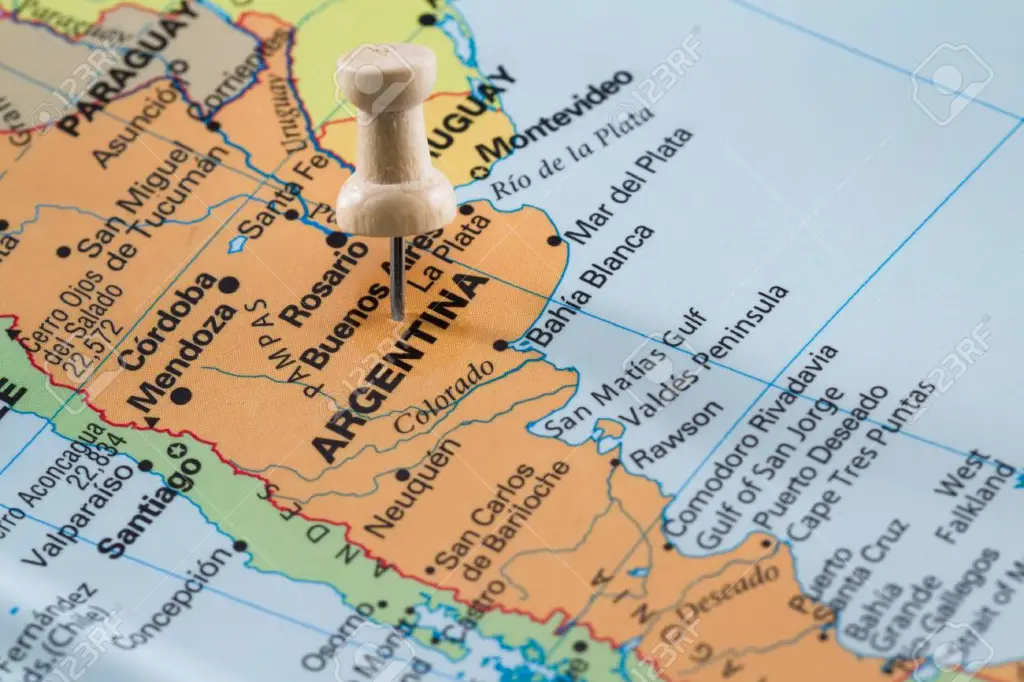
Index to the Contents
- Take Me to the Recipes
- More Articles
- Interesting Facts About Argentina
- The Argentina’s History and the Effect It Has Had on the Cuisine
- How Argentina’s Climate and Geography has Influenced Argentina Cuisine
- Understanding the Essence of Argentina cuisine
- Argentinian Culinary Traditions
- Exploring the Argentina’s Ingredients: The Flavors of Argentina cuisine
- Traditional Argentina Cuisine
- Argentina’s National Dish
- Popular Argentinean Food
- How Healthy is Argentinean Food?
- Argentinean recipes you can Try In your own Kitchen
- Conclusion
- FAQ’s
You may also be interested in the following Articles
- North and South American Cuisine – A Culinary Expedition
- Europe Cuisine: Savor the Continent’s Best Culinary Secrets!
- African Cuisine: Discover the Bold Flavors & Global Charm!
- Asian Cuisine Unlock its Secrets – Taste, Health & Global Influence!
Savor iconic Haitian Food Recipes – Click on each tantalizing picture to open up the Recipe.


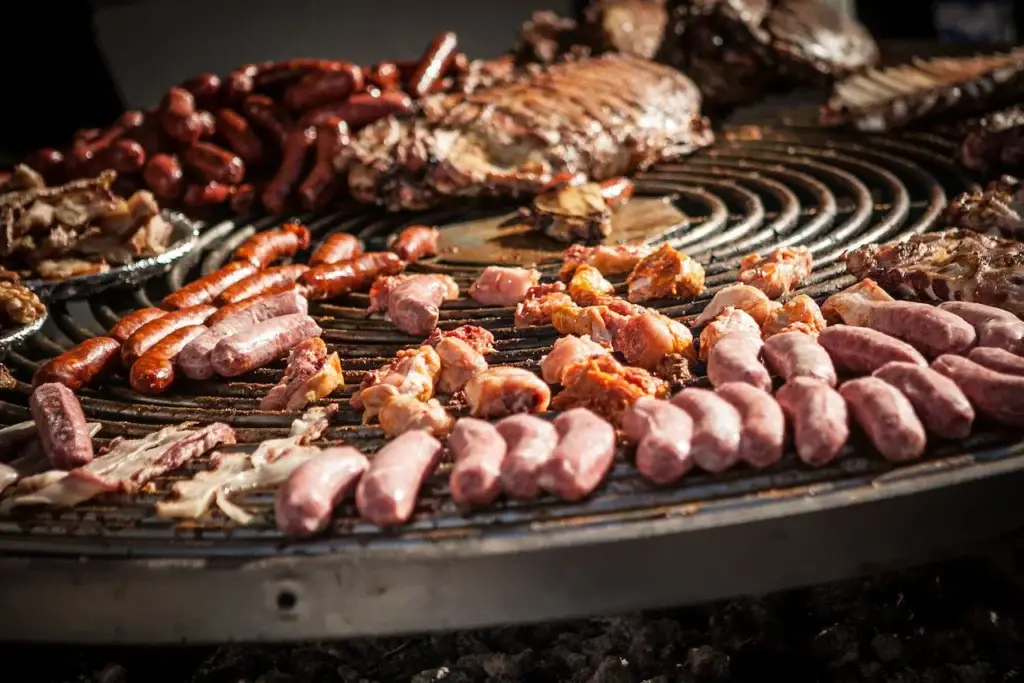
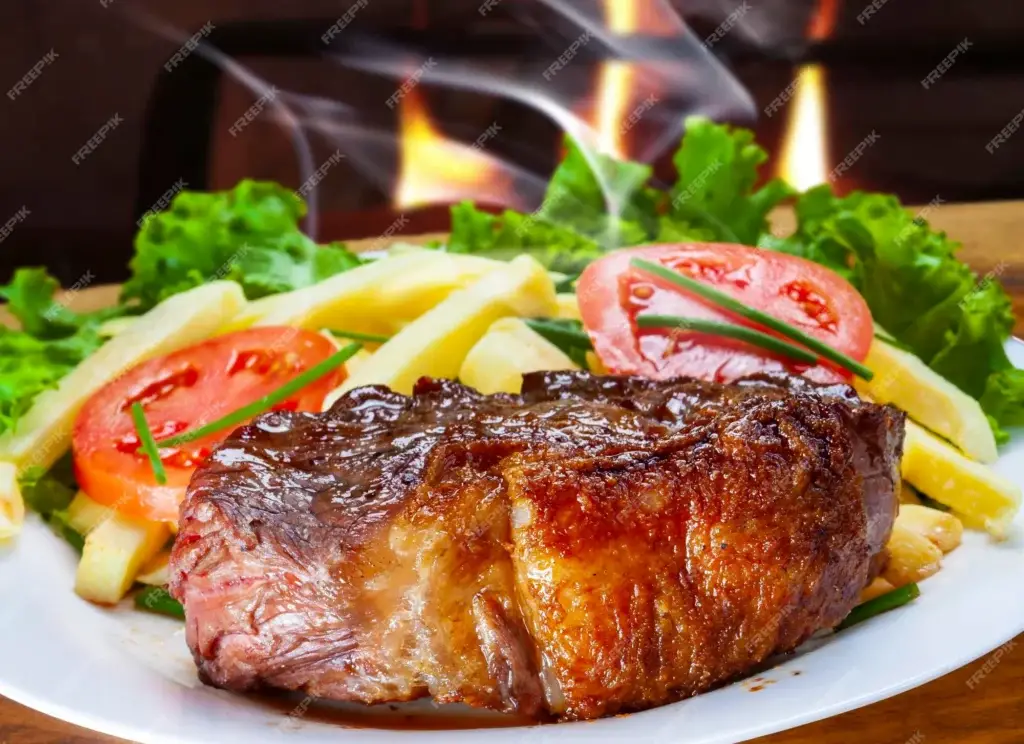
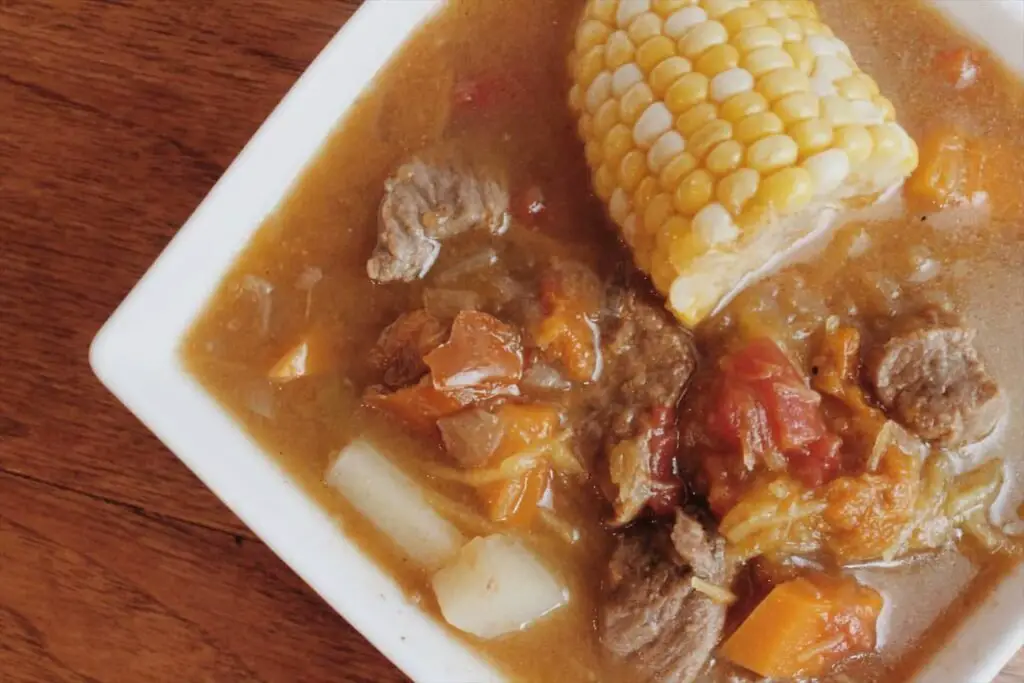


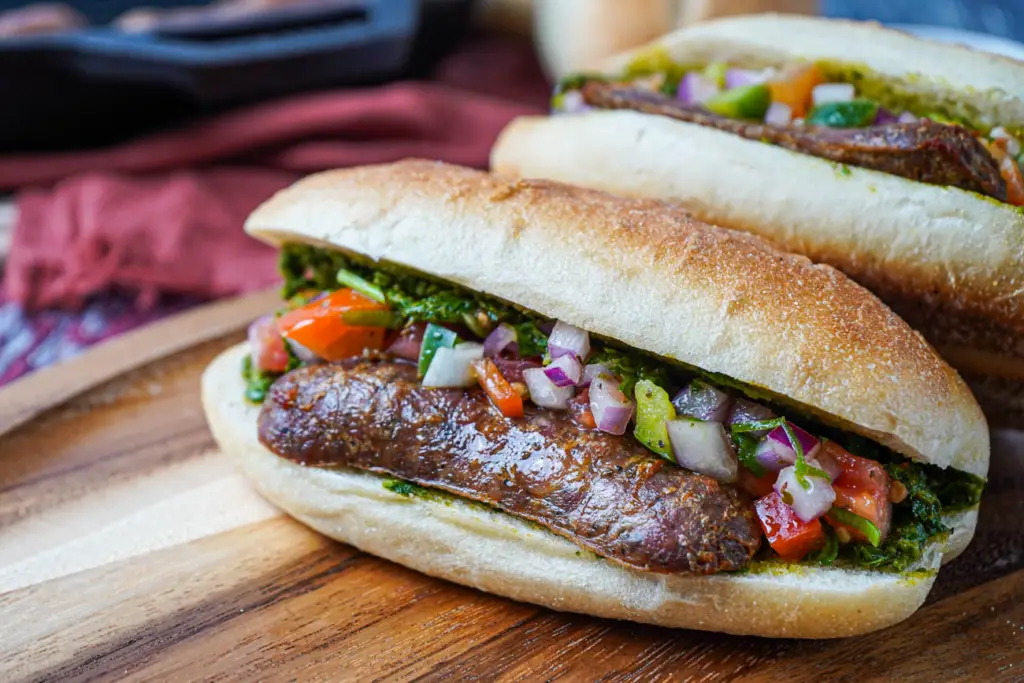
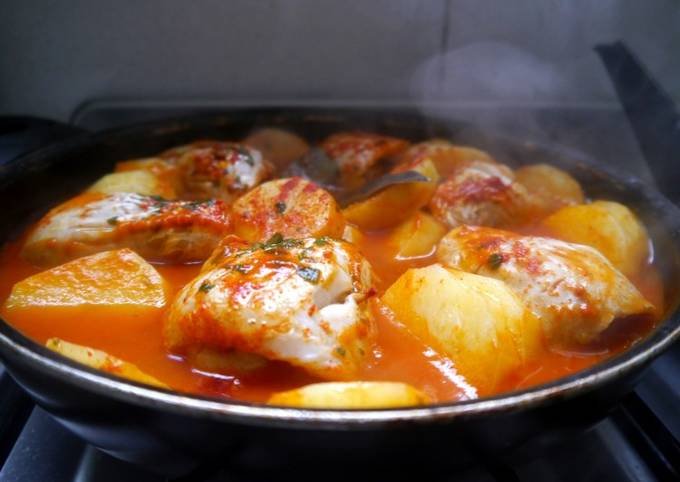
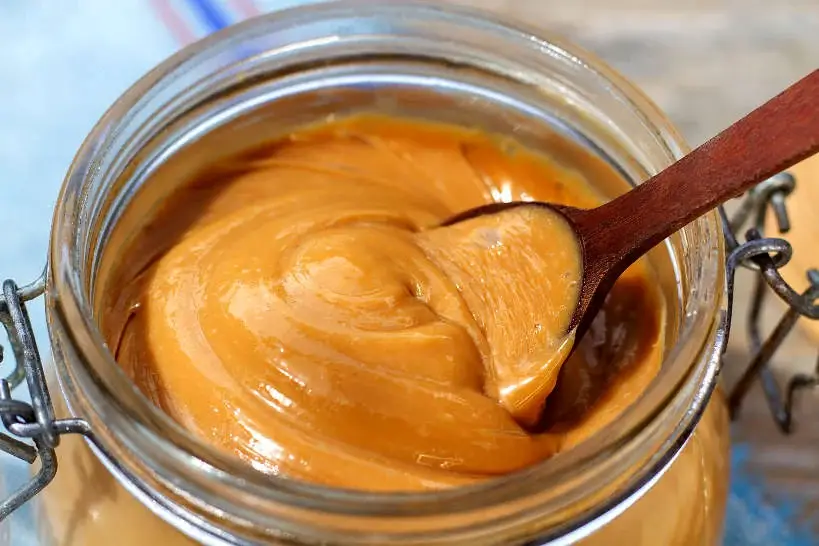
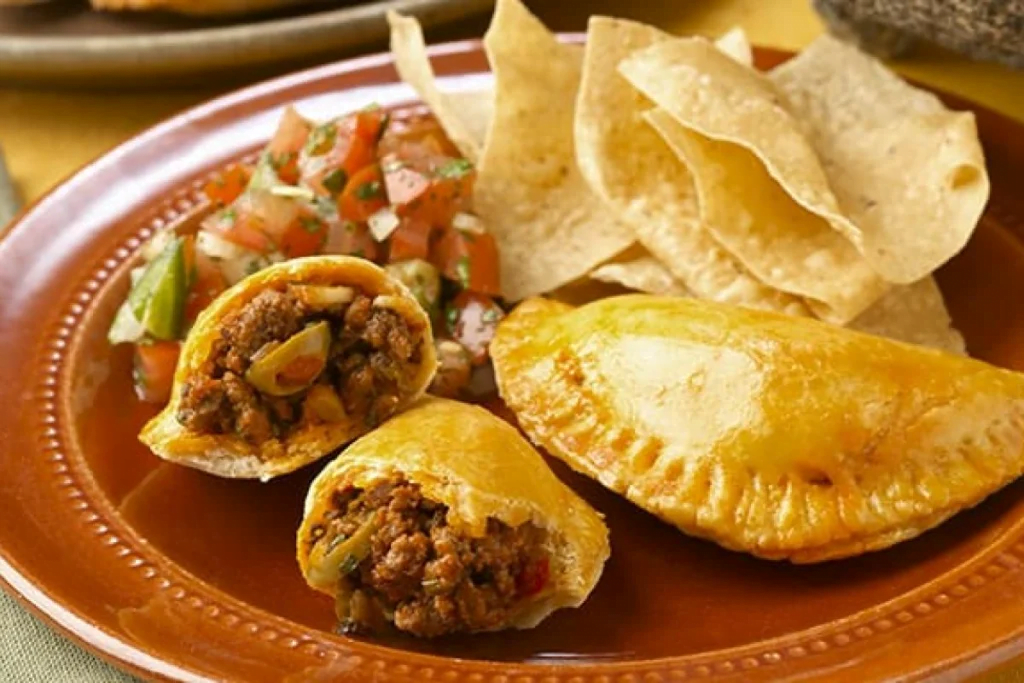
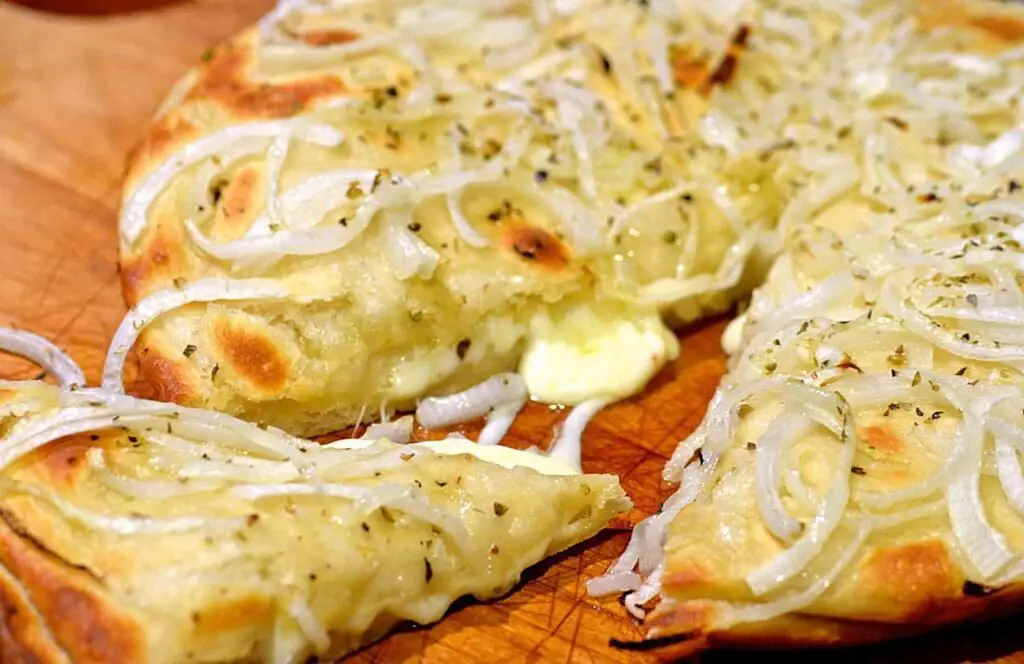
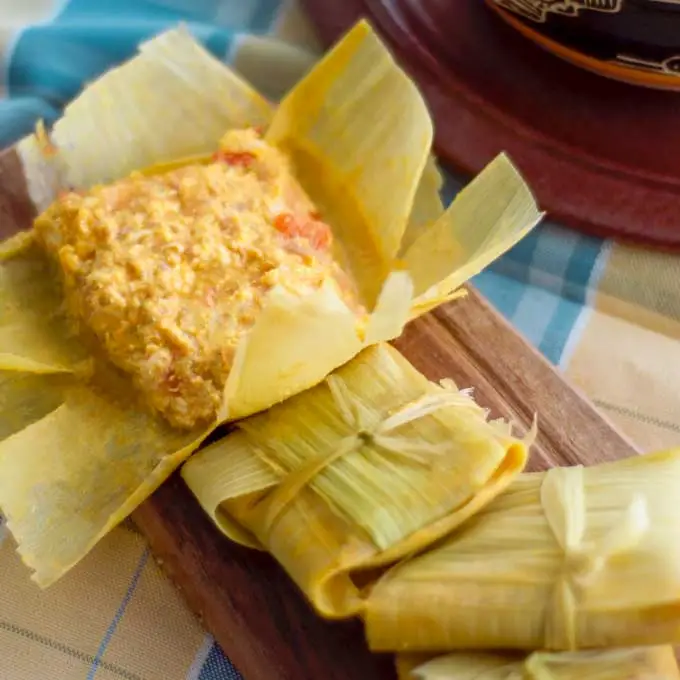
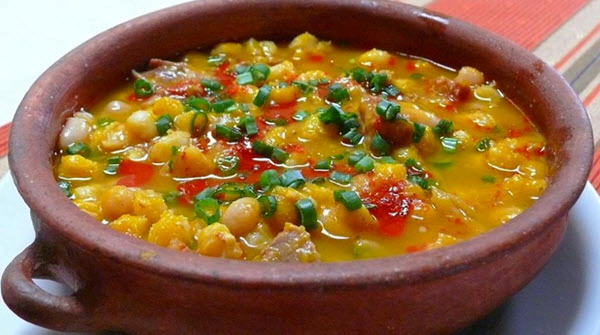
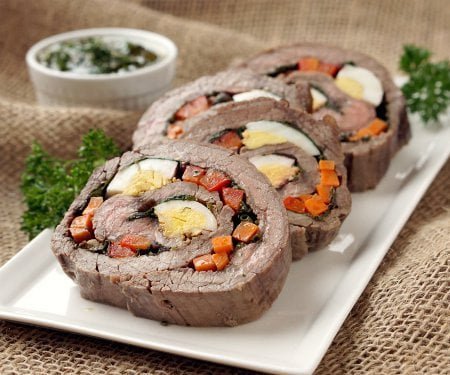
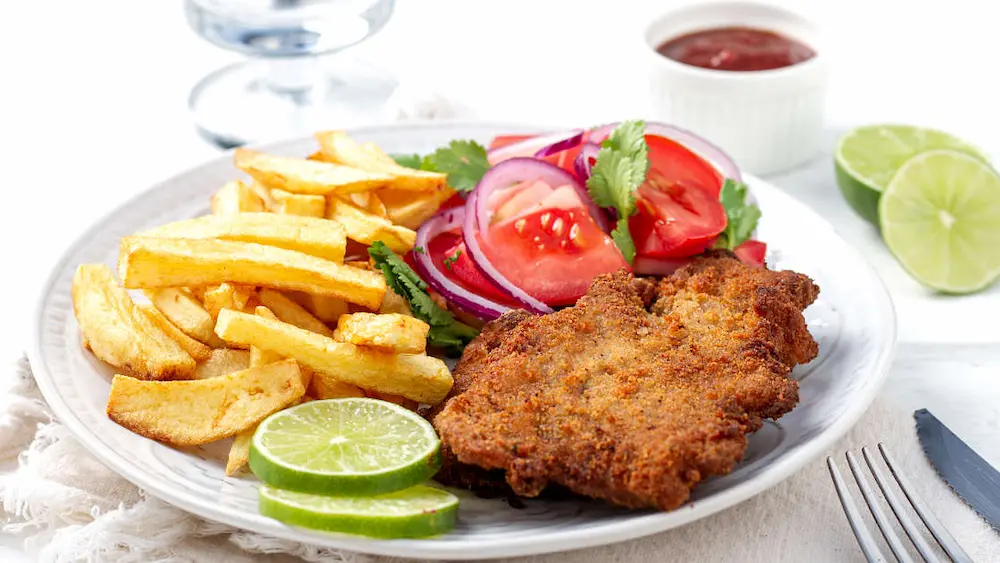

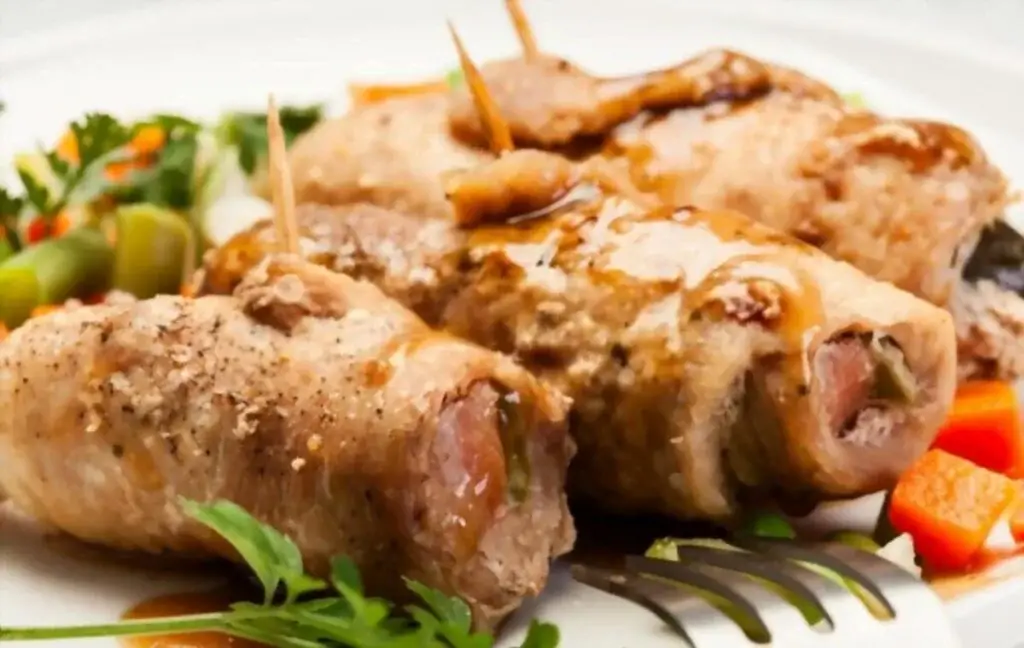
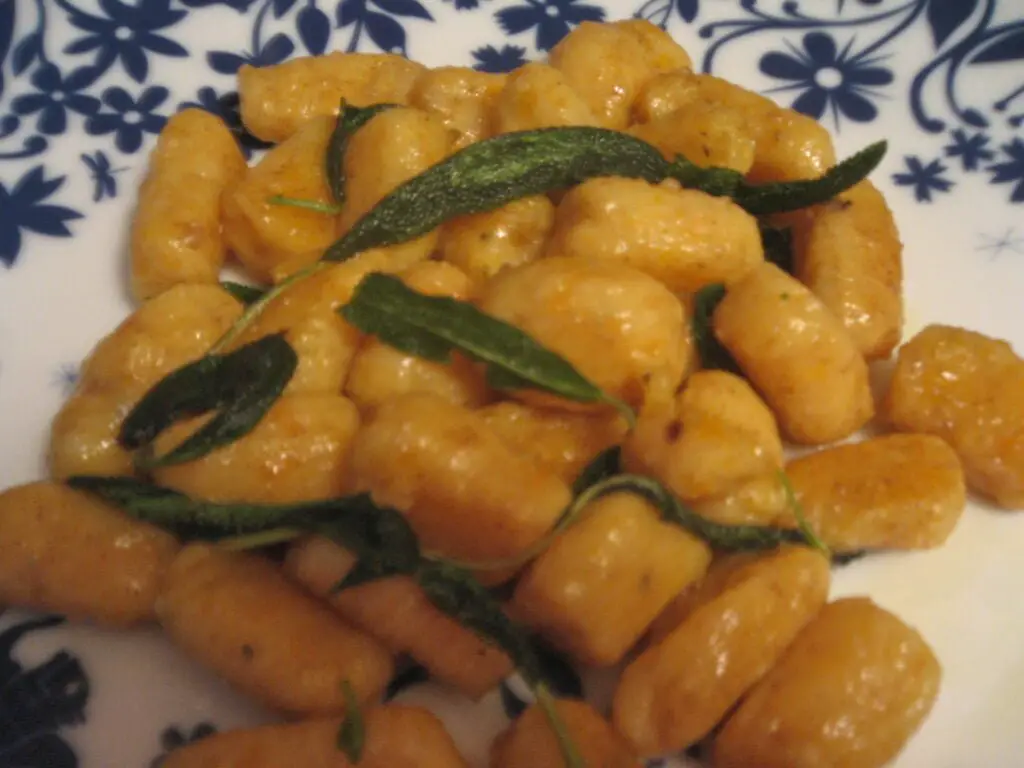
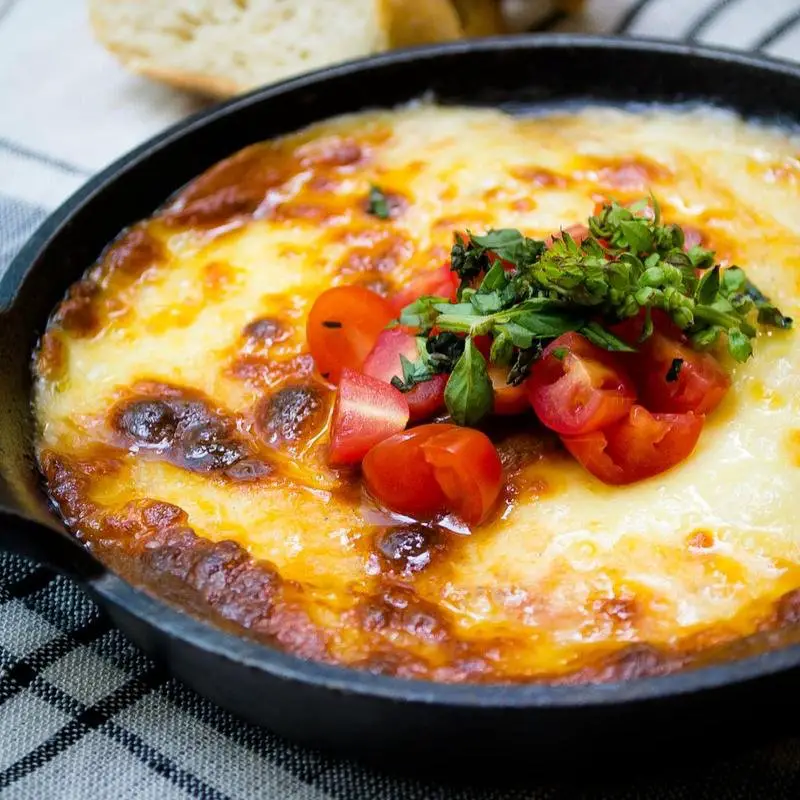
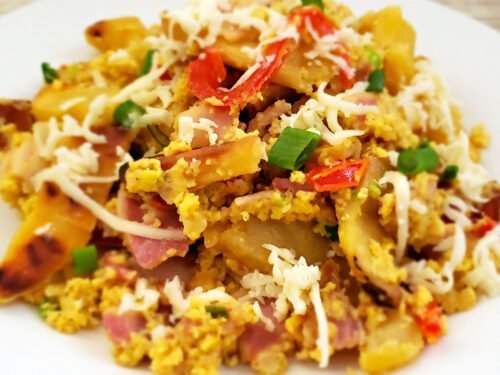
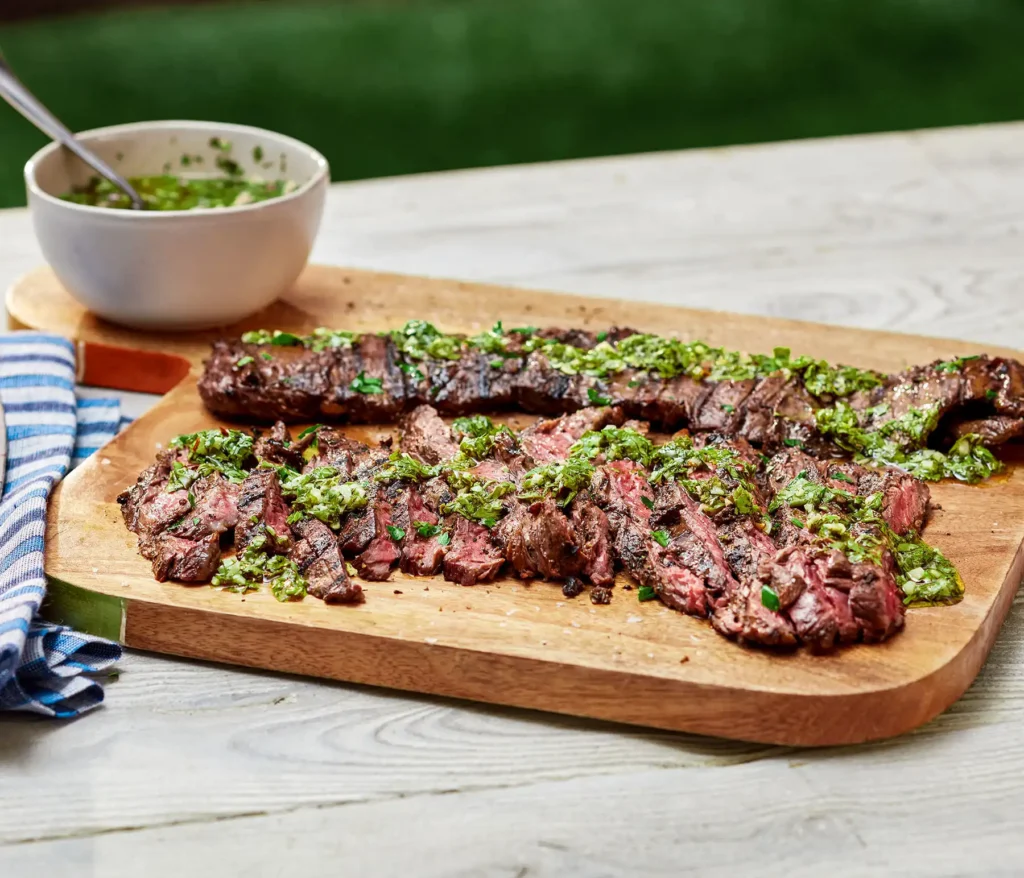
Interesting Facts About Argentina
Tango’s Sultry Embrace

The passionate dance of tango originated in the working-class neighborhoods of Buenos Aires. Evolving from the dance halls to international stages, tango reflects Argentina’s emotional and artistic depth.
Mate Madness
Argentina is known for its love affair with mate, a traditional herbal tea. The act of sharing mate is deeply ingrained in Argentine social culture, fostering connections among friends and family.
Cowboy Culture

Gauchos, Argentina’s cowboys, epitomize the nation’s rural spirit. Clad in traditional attire and skilled in horsemanship, gauchos play a vital role in Argentina’s cattle ranching heritage.
Evita’s Legacy
Eva Perón, affectionately known as Evita, left an indelible mark on Argentine history. As the wife of President Juan Perón, she championed social welfare causes and became a symbol of hope for the nation’s working class.
Perito Moreno Glacier Marvel

Argentina hosts the awe-inspiring Perito Moreno Glacier in Los Glaciares National Park. This mammoth ice formation is one of the few glaciers in the world that continues to advance, creating a breathtaking spectacle.
Football Fervor
Football (soccer) is more than a sport in Argentina; it’s a national passion. The country has produced legendary players like Diego Maradona and Lionel Messi, adding to its football fervor.
Mate and Ice Cream Combo
Argentina holds the distinction of being one of the few places where ice cream consumption rivals that of mate. Enjoying these seemingly contrasting treats is a cherished local custom.
Invasive Species Battle

Argentina faces ecological challenges due to invasive species like the capybara. Despite being native to South America, capybaras in certain regions disrupt local ecosystems, creating a complex environmental scenario.
Crazy Driving Tradition
In a peculiar driving custom, many Argentines honk their car horns while driving through tunnels. This seemingly odd practice is believed to bring good luck and avert potential accidents.
Artistic Street Magic

Buenos Aires boasts vibrant street art scenes, with colorful murals adorning neighborhoods like Palermo. This open-air art gallery reflects the city’s dynamic cultural and artistic identity.
The Argentina’s History and the Effect It Has Had on the Cuisine

Let’s embark on a delicious journey, exploring how each era has shaped this rich and vibrant culinary heritage:
Before the Europeans Arrived (Up to 1536)
Long before conquistadors stepped ashore, indigenous groups thrived across Argentina. Some were hunter-gatherers, navigating the vast plains of Patagonia, while others settled into advanced agrarian societies in the north.
Imagine their meals fueled by wild berries, game, and the early stirrings of agriculture. In the northwest, the Inca influence even brought the gleam of precious metals like silver and copper.
Colonial Encounters (1536-1810)

The arrival of the Spanish in 1516 marked a turning point. They introduced a bounty of new ingredients – potatoes, tomatoes, peppers, and more – that mingled with existing traditions.
Imagine the fusion of European spices with indigenous staples, giving birth to dishes that laid the foundation for Argentinian cuisine as we know it.
Forging a Nation (1810-1880)
As Argentina declared independence in 1816, a love affair with beef blossomed. Vast pampas became home to cattle ranches, and asado – the iconic Argentine barbecue – emerged as a national pastime.
But the culinary scene wasn’t just about grilled meats. Italian and French influences began to seep in, enriching the palate with pasta, pastries, and sophisticated sauces.
Modern Delights (From 1880)

Today, Argentina boasts a diverse cuisine that reflects its vastness and rich tapestry of cultures. Sure, steak remains king, but there’s a world beyond. Imagine savoring juicy empanadas bursting with flavorful fillings, indulging in creamy humita en chala, or dipping crusty bread into the vibrant green goddess that is chimichurri.
From regional specialties to contemporary twists, Argentinian cuisine is a symphony of flavors waiting to be explored.
From the days of hunter-gatherers to the modern melting pot, Argentina’s history is intricately woven into its food. Each bite tells a story – of encounters, adaptations, and a deep appreciation for the land’s bounty. So, the next time you savor a dish from Argentina, remember – you’re not just experiencing deliciousness; you’re tasting a legacy.
References
- History of Argentina – Wikipedia
- Argentinian Cuisine – Wikipedia
- History of Argentina – Britannica
- Place/Argentina – Britannica
- travelfoodatlas.com
How Argentina’s Climate and Geography has Influenced Argentina Cuisine

Imagine a country where mountains cradle succulent lamb, vast plains nurture the world’s best beef, and the ocean delivers an abundance of fresh seafood. Welcome to Argentina, a land where geography weaves a delicious tapestry of flavors.
Let’s embark on a culinary journey, exploring how Argentina’s unique landscape shapes its vibrant cuisine:
Where Mountains Meet Meadows
The imposing Andes, towering along the western border, influence ingredients like succulent lamb, goat, and guanaco, a wild relative of the llama. These hearty proteins thrive in the mountain regions, offering a distinct taste of rugged terrain.
From Pampas to Plate
Step onto the endless Patagonian plains, and you’ll understand why Argentina is synonymous with beef. Lush grasslands provide the perfect breeding ground for cattle, making tender, grilled steaks a national obsession.
Don’t miss the smoky aroma of an asado, a traditional barbecue where various meats sizzle over open flames.
A Feast from the Sea

Turn your gaze towards the long coastline, and you’ll discover a treasure trove of seafood.
Argentina’s diverse waters offer an abundance of fish, shellfish, and other marine delicacies, enriching coastal regions with unique culinary traditions. Imagine diving into a plate of plump shrimp or savoring the delicate flavors of freshly caught salmon.
Climate: Nature’s Culinary Palette

From the subtropical north to the subpolar south, Argentina boasts a diverse climate that paints its culinary canvas with various ingredients. Fertile plains in the Pampas region nurture corn, wheat, and soybeans, forming the base for many dishes.
Meanwhile, temperate areas flourish with vineyards, allowing Argentina to proudly display its world-class wines.
A Legacy of European Spice
The 19th and 20th centuries saw significant immigration from Italy and Spain, leaving their culinary mark on Argentina.
Pizzas, infused with local flavors, tempt every palate. Pasta dishes take on Argentine twists, and Spanish tortillas offer a taste of Mediterranean sunshine. Ingredients like olive oil, garlic, and herbs became staples, adding depth and complexity to local favorites.
In Conclusion:
Argentina’s cuisine is a delicious harmony of indigenous ingredients, European influences, and a deep appreciation for quality meats. Each bite takes you on a journey across diverse landscapes, reflecting the rich history and vibrant spirit of this unique nation.
So, the next time you explore Argentine food, remember – you’re not just indulging in your taste buds; you’re experiencing a land where nature and culture meet on a plate.
References
Understanding the Essence of Argentina cuisine
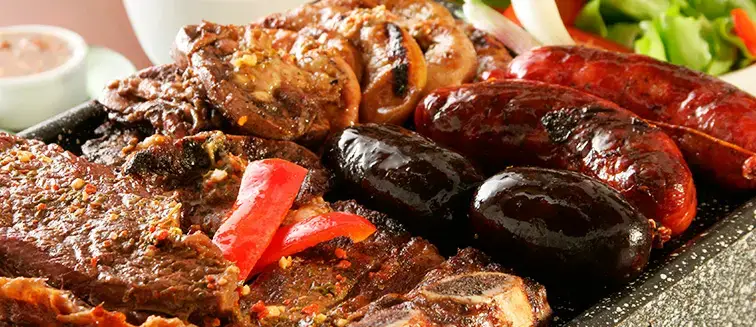
The essence of Argentina cuisine lies in its simplicity and the quality of its ingredients. It’s a cuisine that doesn’t rely on elaborate sauces or spices but rather on the natural flavors of its high-quality produce and meats.
The Argentine asado (barbecue) is a testament to this, where the ritual of grilling is as important as the meal itself, symbolizing the Argentine emphasis on community and sharing. The Italian influence is also significant, with pasta and pizza being as Argentine as empanadas and dulce de leche, showcasing the country’s ability to adopt and adapt international flavors.
Argentinian Culinary Traditions

Argentinian culinary traditions are deeply rooted in the social fabric of the country. The asado is not just a meal but a social event, bringing families and friends together around the grill.
Mate, a traditional infused drink, is a symbol of hospitality and camaraderie. Holidays see the preparation of special dishes like locro, a hearty stew that’s a national favorite.
These traditions are a reflection of the Argentine spirit, with food being the centerpiece of community and celebration.
Exploring the Argentina’s Ingredients: The Flavors of Argentina cuisine
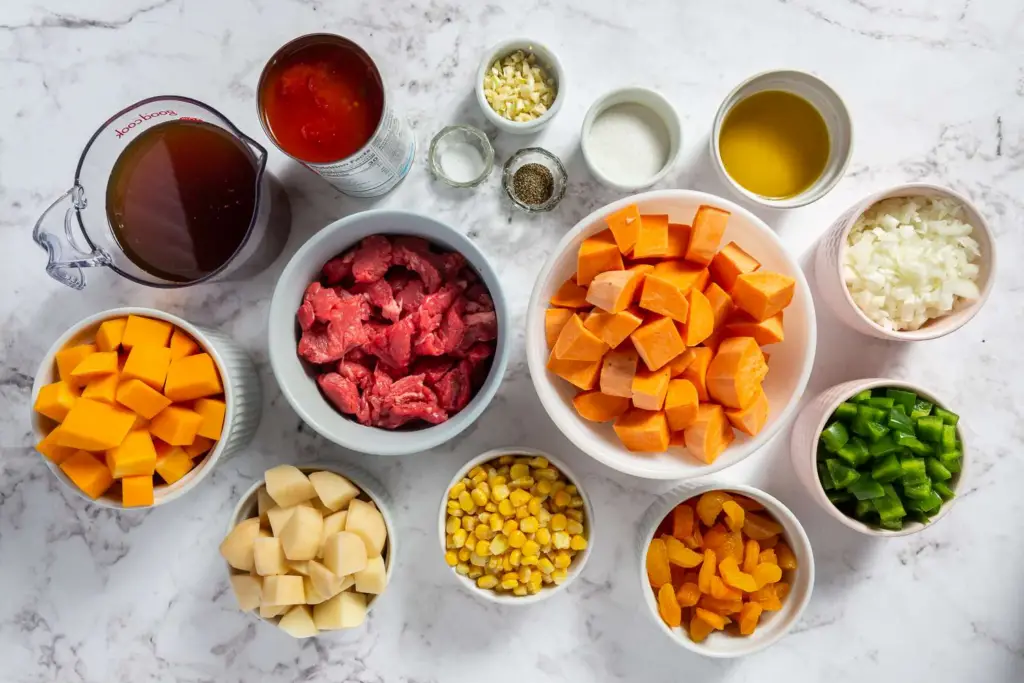
The flavors of Argentina are as bold and vibrant as its landscapes. Key ingredients include:
- Beef: Celebrated in the asado, it’s a national icon.
- Corn: Used in humitas and tamales, it’s a staple inherited from indigenous cultures.
- Yerba Mate: The bitter herb used to make the ubiquitous mate drink.
- Wine: Particularly Malbec, which has become synonymous with Argentine viticulture.
- Dulce de Leche: A sweet caramel used in desserts nationwide.
- Cheese: With Italian influence, cheeses like mozzarella are common in everyday cuisine.
These ingredients, among others, are the building blocks of Argentine cuisine, creating a culinary identity that is both distinctive and welcoming, much like Argentina itself.
Traditional Argentina Cuisine
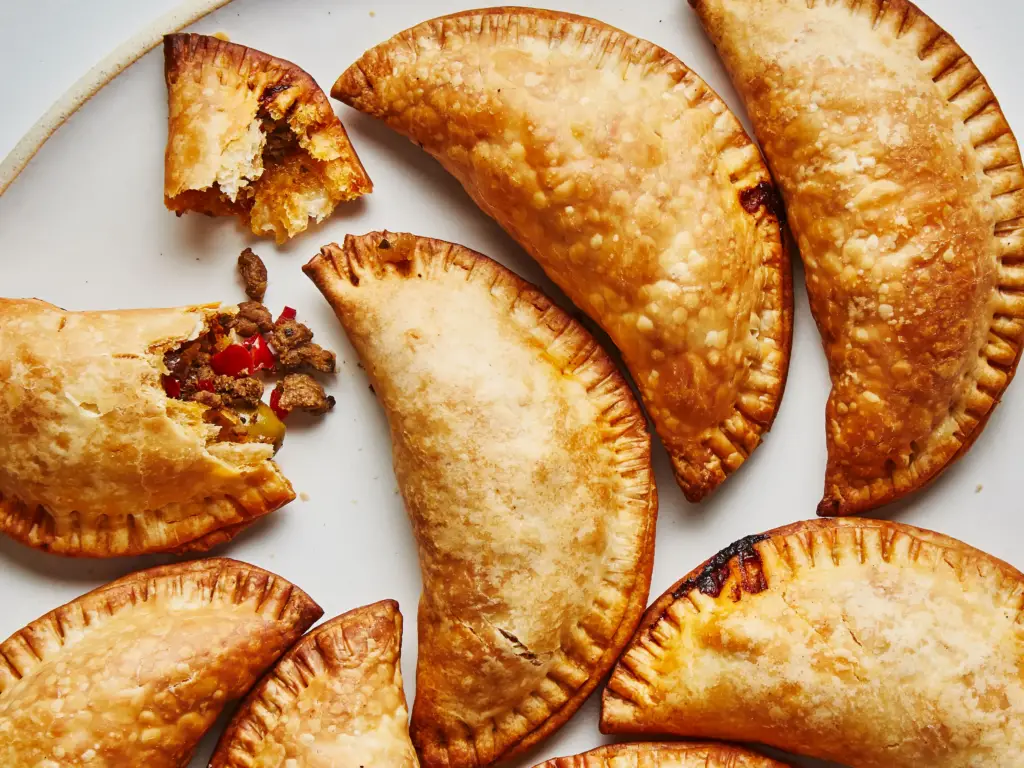
When it comes to typical Argentine cuisine, there is no shortage of famous dishes to choose from. From the mouthwatering steak to the savory empanadas, Argentine food is a culinary delight that has gained popularity all over the world.
The backbone of Argentina Cuisine is the meat dishes, particularly beef. The meat is often grilled or barbecued and served with a variety of side dishes such as salads, vegetables, and potato dishes. Some of the most famous beef dishes include bife de chorizo, a juicy sirloin steak, and vacio, a flavorful flank steak.
But Argentina Cuisine is not just about meat. Hearty stews and soups such as locro and carbonada are also popular, especially during the colder months. And let’s not forget about the pastries – Argentine empanadas are a staple in the country and come in a variety of flavors, including beef, chicken, and cheese.
Other famous Argentina Cuisine dishes include the Milanesa, a breaded and fried meat cutlet, and the choripan, a chorizo sausage served on crusty bread with chimichurri sauce. And for dessert, dulce de leche is the ultimate Argentine sweet treat, served in cakes, pastries, and even spread on toast.
With all these delectable dishes, it’s no wonder that Argentine cuisine has gained worldwide fame. So next time you’re looking to try something new, give these famous Argentine dishes a try and discover why they have become a culinary sensation!
Argentina’s National Dish
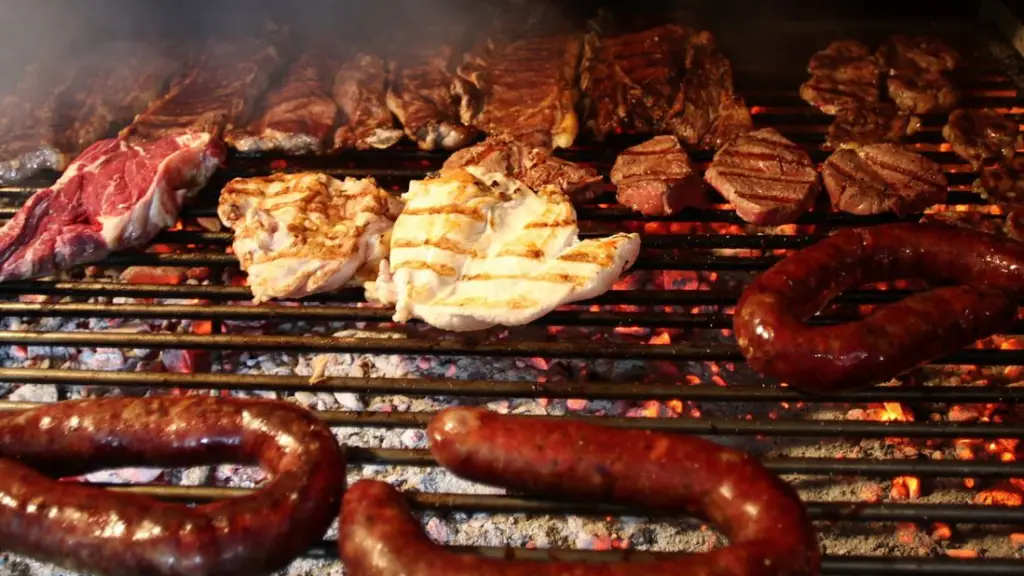
Argentina’s National Dish is asado, which are traditional Argentine barbecues. Asados consist of various cuts; of meat, such as beef, pork, and chicken, cooked slowly over an open fire or on a grill.
This method of cooking allows the meat to develop a rich and smoky flavor, making it incredibly tender and juicy. Asados are often enjoyed with chimichurri sauce, a vibrant and tangy condiment made with parsley, garlic, vinegar, and oil.
The love for asados runs deep in Argentina, as they are not only a meal but also a social and cultural gathering that brings friends and family together. The Argentinean National Dish is a true celebration of Argentine cuisine and traditions.
Popular Argentinean Food

The following are 10 of the most popular food dishes in Argentina.
Asado
The undisputed king of Argentine cuisine, asado is a social event and culinary highlight. This traditional barbecue features various grilled meats, especially juicy beef cuts, sausage, and organ meats. Enjoyed outdoors with chimichurri sauce, it’s a must-try for meat lovers.
Empanadas
These savory turnovers come in countless variations, filled with meat, cheese, vegetables, or even combinations. Baked or fried, they’re perfect as snacks, appetizers, or light meals, offering a delightful explosion of flavors in every bite.
Locr
This hearty stew is steeped in history and comfort. Packed with potatoes, corn, beans, meat, and chorizo, it’s a delicious way to experience Argentine comfort food with a touch of indigenous influence.
Humita en chala
This unique dish features fresh corn kernels steamed in corn husks, creating a creamy and flavorful treat. Often seasoned with herbs and cheese, it’s a simple yet satisfying vegetarian option.
Matambre Arrollado
This impressive dish involves thinly sliced beef rolled and stuffed with vegetables, herbs, and sometimes hard-boiled eggs. Braised or boiled, it’s then sliced and served cold, offering a complex and savory experience.
Milanesa
This breaded and fried meat cutlet, usually beef or chicken, is a popular and versatile dish. Often served with fries or mashed potatoes, it’s a kid-friendly favorite with a crispy and comforting appeal.
Ñoquis del 29
These gnocchi-like dumplings are traditionally eaten on the 29th of each month for good luck and prosperity. Made with potatoes and various sauces, they’re a fun and delicious tradition to experience.
Choripán
This street food hero combines a savory chorizo sausage nestled in a warm bread roll, often accompanied by chimichurri sauce. Simple yet satisfying, it’s a quintessential taste of Argentine street food culture.
Carbonada
This slow-cooked beef stew features pumpkin, sweet potatoes, and other vegetables, creating a rich and flavorful dish. Perfect for chilly days, it offers a unique blend of savory and sweet notes.
Alfajores
These melt-in-your-mouth shortbread cookies sandwich a layer of dulce de leche, a sweet milk caramel spread. A favorite dessert and souvenir, they come in various flavors and sizes, offering a delightful ending to any meal.
This list just scratches the surface of Argentina’s diverse and delicious cuisine. Explore further and discover your own favorites – your taste buds will thank you!
How Healthy is Argentinean Food?
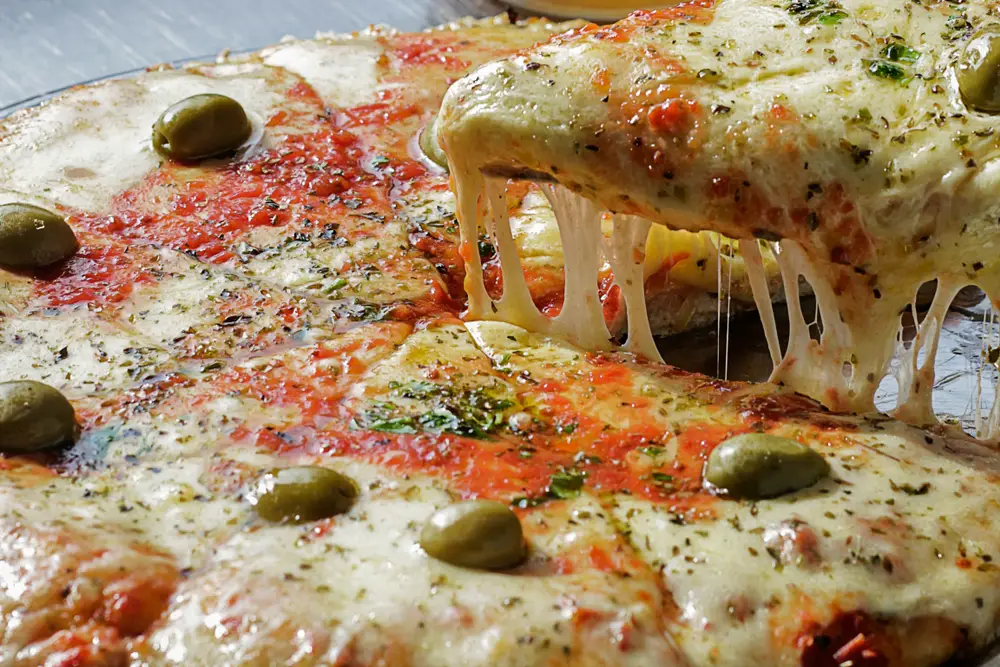
Argentina’s cuisine dances between a vibrant fiesta of flavors and the delicate steps of healthy living. Let’s explore the delicious complexities and health considerations of this captivating food culture, using reliable references to paint a nuanced picture.
Navigating the Guidelines
Argentina boasts Food-Based Dietary Guidelines (FBDGs) promoting balanced plates, active bodies, and clean water.
Think colorful veggies and fruits, 30 minutes of movement daily, and sipping safe H2O. Reducing salt and avoiding sodium bombs are also key.
The Traditional Twist
Classic Argentinian dishes like flavorful beef-centric creations may require a healthy spin. Here’s the secret: choose lean cuts, embrace plant-based powerhouses, and drizzle healthy fats with moderation.
Challenges on the Plate
Like many nations, Argentina faces an obesity hurdle, impacting both women and men. Non-communicable diseases (NCDs) loom large, with heart woes claiming a significant number of lives. Diabetes, high cholesterol, hypertension, and even cancer risk dance alongside the traditional plate.
Food and Health: A Complex Tango
- Diabetes: Rising sugar levels pose a threat, linked to both diet and lifestyle factors.
- Heart Disease: The Tango with red meat and saturated fats can lead to an unhealthy rhythm for the heart.
- High Cholesterol: Fatty feasts and processed foods can clog the arteries with unwanted cholesterol.
- Hypertension: Overdoing the salt shaker can raise blood pressure and put a strain on the system.
- Cancer Risk: While red meat holds a special place, moderation is key to minimizing potential risks.
- Digestive Disorders: A heavy focus on meat might lead to tummy troubles.
Finding Harmony
The answer lies in finding balance. Exploring vegetarian options, whole grains, and healthy cooking methods can create a symphony of flavor and well-being. Remembering moderation and incorporating physical activity are also key steps in this beautiful dance.
References
- Food-Based Dietary Guidelines – Argentina.
- Global Table: Argentina.
- The Argentine Diet Is A Perfect Recipe for Unhealthy Living.
- Top 20 Healthy Argentinean Dishes.
- Argentina Nutrition Profile.
- Health Profile Argentina.
- Making Universal Health Care Effective in Argentina.
Argentinean Recipes you can Try In your own Kitchen
Are you ready to try your hand at Argentinean? With a few key ingredients and some simple techniques, you can bring the authentic taste of Argentina into your own kitchen. Here are some recipes to get you started:
Argentina Food – Locro

Argentina Food – Locro: A Hearty Taste of Tradition
Indulge in the heartwarming embrace of Argentina’s beloved dish, Locro. Originating from the indigenous Andean communities, this hearty stew has woven its way into the cultural fabric, embodying the nation’s diverse culinary history.
History and Background:
Locro finds its roots in pre-Columbian times when indigenous peoples cultivated maize, potatoes, and beans. Over the centuries, Spanish influences merged with native traditions, creating a culinary masterpiece. Today, Locro is a symbol of Argentine identity, especially during national celebrations.
Argentina Food – Ingredients:
- 1 cup dried white corn kernels
- 1 lb pork belly, diced
- 1 lb chorizo sausage, sliced
- 1 large onion, finely chopped
- 2 cloves garlic, minced
- 1 lb potatoes, peeled and diced
- 1 lb sweet potatoes, peeled and diced
- 1 can white hominy, drained
- 1 bunch green onions, chopped
- 1 cup butternut squash, diced
- 1 tsp ground cumin
- Salt and pepper to taste
- 1 tbsp paprika
- 6 cups chicken or vegetable broth
- 1 cup milk
- 1 cup fresh white cheese, diced (for garnish)
- Fresh parsley, chopped (for garnish)
Argentina Food – Recipe:
Servings: 6-8
Cooking Time: 2 hours
- Prepare the Corn:
- Soak the dried corn kernels overnight in water.
- Start the Stew:
- In a large pot, cook pork belly until browned. Add chorizo, onions, and garlic. Sauté until onions are translucent.
- Add Vegetables:
- Incorporate potatoes, sweet potatoes, hominy, green onions, and butternut squash. Stir in cumin, salt, pepper, and paprika.
- Simmer to Perfection:
- Pour in the broth and milk. Bring to a boil, then reduce heat to a simmer. Add soaked corn kernels. Let it cook, stirring occasionally, for about 1.5 to 2 hours until the corn is tender.
- Adjust Seasoning:
- Taste and adjust the seasoning according to your preference.
- Serve and Garnish:
- Ladle the Locro into bowls. Top with diced white cheese and chopped fresh parsley.
- Enjoy the Comfort:
- Dive into the comforting warmth of Locro, savoring the rich flavors and cultural heritage it brings to your table.
Nutritional Information (Per Serving):
- Calories: 450 kcal
- Protein: 20g
- Carbohydrates: 45g
- Fat: 22g
- Fiber: 8g
Immerse yourself in the culinary traditions of Argentina with this Locro recipe, a celebration of flavors that transcends time and brings a piece of Argentine history to your home.
Argentina Food – Choripán

Argentina Food – Choripán: A Sizzling Tango of Flavors
Embark on a culinary journey through Argentina with the iconic Choripán, a street food sensation that captures the essence of Argentine grilling culture. As a food blogger and restaurant owner, I bring you this sizzling delight that fuses the bold flavors of chorizo and the simplicity of a bread roll.
History and Background:
Choripán, a portmanteau of chorizo (sausage) and pan (bread), is deeply rooted in Argentine culture. Originating from the vibrant street food scene, this dish became a staple at asados (barbecues) and football matches. It symbolizes the spirit of togetherness and the love Argentinians have for their cherished grilled meats.
Argentina Food – Ingredients:
- 4 Argentine chorizo sausages
- 4 crusty bread rolls
- 1 cup chimichurri sauce
- 1 red onion, thinly sliced (optional, for garnish)
Argentina Food – Recipe:
Servings: 4
Cooking Time: 15 minutes
Calories (Per Serving): Approximately 500 kcal
Instructions:
1. Grill the Chorizo:
- Preheat your grill or barbecue. Grill the chorizo sausages over medium heat, turning occasionally, until they are cooked through and have a beautiful char.
2. Prepare the Bread:
- While the chorizo is grilling, cut the bread rolls in half, keeping them connected on one side, creating a pocket to hold the sausage.
3. Warm the Bread:
- Place the cut side of the bread rolls on the grill for a minute or until lightly toasted. This step enhances the flavor and adds a delightful crunch.
4. Assemble the Choripán:
- Insert a grilled chorizo sausage into each bread pocket. Add a generous drizzle of chimichurri sauce over the sausage.
5. Garnish (Optional):
- For an extra kick, top your Choripán with thinly sliced red onions.
6. Serve and Enjoy:
- Present the Choripán on a platter, encouraging everyone to grab a piece. Dive into this culinary tango of flavors, savoring the smokiness of the chorizo and the zesty freshness of chimichurri.
Capturing the spirit of Argentine street food, Choripán invites you to experience the vibrant and social aspect of Argentine cuisine. Perfect for gatherings or a casual bite, this dish encapsulates the passion and zest for life that Argentina is renowned for.
Argentina Food – Humita En Chala

Argentina Food – Humita En Chala: A Corny Delight from the Pampas
Welcome to the heart of Argentine cuisine with a recipe that sings the melody of the vast Pampas region – Humita En Chala. As a food blogger and restaurant owner, I’m thrilled to share the rich history and flavors of this traditional dish that pays homage to Argentina’s agricultural roots.
History and Background:
Humita En Chala, a humble and hearty dish, traces its origins to the indigenous communities of the Pampas, where corn is a staple. It reflects the agricultural essence of Argentina, capturing the spirit of simplicity and sustainability. Traditionally, this dish is made during the corn harvest season, bringing families together to celebrate the bounty of the land.
Argentina Food – Ingredients:
- 6 large ears of fresh corn
- 1 onion, finely chopped
- 1 red bell pepper, diced
- 1 cup milk
- 1/2 cup lard or butter
- 1 teaspoon paprika
- Salt and pepper to taste
- Corn husks for wrapping
Argentina Food – Recipe:
Servings: 6
Cooking Time: 45 minutes
Calories (Per Serving): Approximately 250 kcal
Instructions:
1. Prepare Corn Husks:
- Soak the corn husks in warm water for at least 30 minutes to make them pliable for wrapping.
2. Grate Corn Kernels:
- Grate the fresh corn kernels off the cobs using a box grater. Collect the grated corn in a large mixing bowl.
3. Sauté Vegetables:
- In a skillet, sauté finely chopped onions and diced red bell pepper in lard or butter until they are soft and fragrant.
4. Mix Corn Mixture:
- Combine the grated corn, sautéed vegetables, milk, paprika, salt, and pepper in the mixing bowl. Mix well to create a creamy consistency.
5. Assemble Humitas:
- Take a soaked corn husk, place a generous amount of the corn mixture in the center, and wrap it into a rectangular parcel, securing the ends.
6. Steam Humitas:
- Arrange the wrapped humitas in a steamer. Steam for 30-40 minutes until the corn mixture firms up.
7. Serve and Enjoy:
- Unwrap the steamed humitas and present them on a platter. Delight in the wholesome flavors that echo the agricultural traditions of Argentina.
Humita En Chala serves as a delicious ode to the Pampas, blending the sweetness of fresh corn with the savory notes of sautéed vegetables. Embrace the Argentine countryside on your plate with this authentic and comforting dish, perfect for sharing with loved ones.
Argentina Food – Matambre Arrollado

Argentina Food – Matambre Arrollado: A Gastronomic Journey Through the Pampas
Welcome to the vibrant world of Argentine cuisine! Today, we’re exploring the delightful Matambre Arrollado, a savory roll that encapsulates the flavors of the vast Pampas region. As a food blogger and restaurant owner, I’m excited to share the history, ingredients, and a step-by-step recipe of this Argentine classic that will transport you to the heart of South American culinary traditions.
History and Background:
Originating from the Pampas, Matambre Arrollado is deeply rooted in Argentine barbecue culture. “Matambre” translates to “kill hunger,” and this dish does just that. It’s a roll of thinly sliced beef, showcasing the skillful artistry of Argentine cooks and the love for communal feasting.
Often enjoyed during gatherings, this dish has become a symbol of togetherness and culinary prowess.
Argentina Food – Matambre Arrollado Ingredients:
- 1 whole matambre (flank steak), approximately 2-3 pounds
- 1 cup boiled spinach, finely chopped
- 1 cup roasted red bell peppers, thinly sliced
- 1 cup hard-boiled eggs, sliced
- 1 cup carrots, boiled and julienned
- 1/2 cup green onions, finely chopped
- 3 cloves garlic, minced
- Salt and pepper to taste
- Olive oil for brushing
Argentina Food – Matambre Arrollado Recipe:
Servings: 6-8
Cooking Time: 2 hours (including marination and grilling)
Calories (Per Serving): Approximately 300 kcal
Instructions:
1. Prepare the Flank Steak:
- Lay the matambre flat and make lengthwise cuts without fully slicing through, creating a flat piece of beef.
2. Marinate the Meat:
- Rub minced garlic, salt, and pepper over the matambre. Allow it to marinate for at least 30 minutes.
3. Layer the Ingredients:
- Evenly spread chopped spinach, sliced roasted red peppers, boiled eggs, julienned carrots, and chopped green onions over the marinated matambre.
4. Roll and Secure:
- Carefully roll the matambre, creating a log with the layered ingredients inside. Secure the roll with kitchen twine.
5. Grill the Roll:
- Preheat the grill. Brush the matambre roll with olive oil and grill over medium heat until it reaches your desired level of doneness, approximately 30-40 minutes.
6. Rest and Slice:
- Let the Matambre Arrollado rest for 10 minutes before slicing it into pinwheels.
7. Serve and Enjoy:
- Arrange the slices on a platter, showcasing the colorful layers. Dive into a bite of Argentine tradition, celebrating the art of grilling and the flavors of the Pampas.
Matambre Arrollado is a culinary spectacle that captures the essence of Argentine barbecue mastery. Gather around, savor the rich flavors, and immerse yourself in the culinary heritage of the Pampas with this delightful dish.
Argentina Food – Milanesa

Argentina Food – Milanesa: A Crispy Culinary Tale from Buenos Aires
Indulge in the iconic Argentine dish, Milanesa, a true crowd-pleaser that has found its way from the bustling streets of Buenos Aires to the hearts of food enthusiasts worldwide. As a passionate food blogger and restaurant owner, let’s delve into the rich history, gather our ingredients, and embark on a journey to create the perfect Milanesa – a dish loved by all ages.
History and Background:
The roots of Milanesa can be traced back to the Italian Cotoletta, brought to Argentina by Italian immigrants. The dish, embraced and adapted by locals, evolved into the beloved Milanesa. Typically made with thinly pounded meat, breaded and fried to golden perfection, it reflects the fusion of culinary traditions that define Argentina’s diverse gastronomy.
Argentina Food – Milanesa Ingredients
- 4 beef or chicken cutlets, pounded thin
- Salt and pepper to taste
- 1 cup all-purpose flour
- 2 large eggs
- 2 cups breadcrumbs
- 1 cup vegetable oil (for frying)
- Lemon wedges for serving
Argentina Food – Milanesa Recipe
Servings: 4
Cooking Time: 20 minutes
Calories (Per Serving): Approximately 400 kcal
Instructions:
1. Prepare the Cutlets:
- Season the meat with salt and pepper. Pound the cutlets to an even thickness, ensuring they cook evenly.
2. Set Up Breading Station:
- In three separate bowls, place flour, beaten eggs, and breadcrumbs.
3. Bread the Cutlets:
- Dredge each cutlet in flour, ensuring an even coating. Dip into the beaten eggs, then coat generously with breadcrumbs, pressing gently to adhere.
4. Heat Oil for Frying:
- In a large skillet, heat vegetable oil over medium-high heat until it reaches 350°F (180°C).
5. Fry the Milanesa:
- Carefully place the breaded cutlets into the hot oil. Fry for 3-4 minutes per side, or until golden brown and crispy.
6. Drain and Rest:
- Transfer the Milanesa to a paper towel-lined plate to drain excess oil. Allow them to rest for a few minutes.
7. Serve with Lemon:
- Plate the Milanesa and serve with lemon wedges on the side for a zesty kick.
8. Enjoy the Crispy Delight:
- Dive into the delightful world of Milanesa, savoring the golden, crispy exterior that gives way to tender, flavorful meat.
Milanesa is a cherished dish that brings families and friends together, embodying the warmth and passion of Argentine hospitality. Elevate your culinary skills and create a memorable dining experience with this classic recipe that pays homage to the vibrant streets of Buenos Aires.
Argentina Food – Ñoquis Del 29

Argentina Food – Ñoquis Del 29: A Culinary Tradition Rooted in Good Fortune
As a globetrotting food enthusiast and proud restaurant owner, let me introduce you to a unique Argentine culinary tradition – Ñoquis Del 29. Originating from the vibrant streets of Argentina, this dish is more than just a flavorful delight; it’s a celebration of good luck and community. Let’s explore the history, gather our ingredients, and master the art of crafting these delectable potato dumplings.
History and Background:
Ñoquis Del 29, also known as Gnocchi Day, is a cherished Argentine tradition with deep roots in Italian influence. Celebrated on the 29th day of each month, it holds a special place in the hearts of Argentinians who believe that consuming ñoquis on this day brings prosperity and good fortune. The custom arose from the idea that the end of the month, often financially challenging, could be eased by a humble yet satisfying dish.
Argentina Food – Ñoquis Del 29 Ingredients:
- 2 large potatoes, boiled and mashed
- 1 egg, beaten
- 1 cup all-purpose flour
- Salt and nutmeg to taste
- Tomato sauce and grated Parmesan for serving
Argentina Food – Ñoquis Del 29 Recipe:
Servings: 4
Cooking Time: 40 minutes
Calories (Per Serving): Approximately 250 kcal
Instructions:
1. Prepare the Potatoes:
- Boil the potatoes until tender. Mash them thoroughly and let them cool.
2. Form the Dough:
- In a large bowl, combine the mashed potatoes, beaten egg, flour, salt, and a pinch of nutmeg. Mix until a dough forms.
3. Shape the Ñoquis:
- On a floured surface, divide the dough into small portions. Roll each portion into a rope, then cut into bite-sized pieces.
4. Create Indentations:
- Using a fork, create small indentations on each ñoqui. This helps the sauce cling to the dumplings.
5. Cook the Ñoquis:
- Bring a large pot of salted water to a boil. Drop the ñoquis in batches and cook until they float to the surface. Remove with a slotted spoon.
6. Serve with Tomato Sauce:
- Warm tomato sauce in a pan. Gently toss the cooked ñoquis in the sauce until well coated.
7. Garnish and Enjoy:
- Plate the ñoquis, sprinkle with grated Parmesan, and garnish with fresh herbs. Delight in this delightful dish symbolizing luck and abundance.
Celebrate the magic of Argentine traditions with Ñoquis Del 29, a dish that transcends taste, weaving a tale of fortune and shared moments around the dining table. Bring the spirit of Argentina into your kitchen and savor the joyous essence of ñoquis.
Argentina Food – Alfajores

Argentina Food – Alfajores: A Sweet Symphony of Dulce de Leche
Welcome, fellow food enthusiasts, to a journey through Argentina’s sweet side – Alfajores. As both a globetrotting food blogger and a restaurant owner, I’m thrilled to share this delightful treat that encapsulates the essence of Argentine hospitality. Join me as we explore the history, gather the ingredients, and embark on the delightful process of crafting Alfajores.
History and Background:
Originating from the Moorish influence in Spain, Alfajores found their way to Argentina through Spanish colonization. This confectionary delight has become a beloved part of Argentine culture, with numerous regional variations.
Consisting of two shortbread-like cookies sandwiching a luscious layer of dulce de leche and often coated in chocolate or powdered sugar, Alfajores are synonymous with celebrations, teatime, and the warm embrace of Argentine flavors.
Argentina Food – Alfajores Ingredients:
- 1 cup unsalted butter, softened
- 1 cup powdered sugar
- 3 cups all-purpose flour
- 1 teaspoon baking powder
- 1 teaspoon vanilla extract
- 1 cup dulce de leche
- Chocolate coating (optional)
- Shredded coconut for decoration (optional)
Argentina Food – Alfajores Recipe:
Servings: Makes approximately 20 Alfajores
Cooking Time: 20 minutes
Calories (Per Serving): Approximately 150 kcal
Instructions:
1. Prepare the Cookie Dough:
- In a large bowl, cream together the softened butter and powdered sugar until light and fluffy. Add vanilla extract and mix well.
- In a separate bowl, whisk together flour and baking powder. Gradually add this dry mixture to the butter mixture, combining until a soft dough forms.
2. Roll and Cut the Cookies:
- Roll out the dough on a floured surface to about 1/4 inch thickness. Cut out small rounds using a cookie cutter or the rim of a glass.
3. Bake:
- Place the cookies on a parchment-lined baking sheet and bake in a preheated oven at 350°F (180°C) for 10-12 minutes or until the edges are lightly golden. Allow them to cool completely.
4. Assemble the Alfajores:
- Spread a generous layer of dulce de leche on the flat side of one cookie and sandwich it with another cookie.
- Optionally, coat the edges in melted chocolate and roll in shredded coconut for added flair.
5. Serve and Indulge:
- Let the Alfajores set for a while before serving. Pair them with a cup of Argentine mate or your favorite hot beverage.
Dive into the exquisite world of Argentine desserts with Alfajores – a sweet symphony that harmonizes the richness of dulce de leche with the buttery perfection of shortbread. Perfect for any occasion, these delightful treats capture the heart and soul of Argentina’s culinary prowess.
Argentina Food – Steaks with Chimichurri (Churrasco)

Argentina Food – Steaks with Chimichurri (Churrasco): A Sizzling Tango on Your Plate
Welcome, dear food enthusiasts, to the heart of Argentina’s culinary dance – Churrasco. As both your globetrotting food guide and a proud restaurant owner, I’m thrilled to share this iconic dish that encapsulates the bold flavors of Argentina.
Join me as we delve into the history, gather the ingredients, and embark on a sizzling adventure with Steaks and Chimichurri.
History and Background:
Originating from the Argentine pampas, Churrasco is deeply rooted in the country’s gaucho (cowboy) culture. This dish celebrates the art of grilling and embraces the love for high-quality beef that Argentina is renowned for.
The steaks, seasoned to perfection and accompanied by zesty chimichurri, offer a culinary experience that mirrors the passion and vibrancy of Argentine traditions.
Argentina Food – Steaks with Chimichurri Ingredients:
- 4 beef sirloin steaks (approximately 8 oz each)
- Salt and black pepper to taste
- Olive oil for brushing
- For Chimichurri:
- 1 cup fresh parsley, finely chopped
- 4 cloves garlic, minced
- 1 teaspoon dried oregano
- 1 teaspoon red pepper flakes (adjust to taste)
- 1/2 cup extra virgin olive oil
- 3 tablespoons red wine vinegar
- Salt and black pepper to taste
Argentina Food – Steaks with Chimichurri Recipe:
Servings: Serves 4
Cooking Time: 15 minutes
Calories (Per Serving): Approximately 450 kcal (excluding sides)
Instructions:
1. Prepare the Steaks:
- Preheat the grill to medium-high heat.
- Season the steaks with salt and black pepper on both sides.
2. Grill the Steaks:
- Brush the steaks with olive oil to prevent sticking.
- Grill the steaks for about 4-5 minutes per side for medium-rare (adjust based on desired doneness).
3. Make Chimichurri:
- In a bowl, combine chopped parsley, minced garlic, dried oregano, red pepper flakes, olive oil, and red wine vinegar.
- Season the chimichurri with salt and black pepper. Allow it to sit for flavors to meld.
4. Serve and Enjoy:
- Once the steaks are grilled to perfection, remove them from the grill and let them rest for a few minutes.
- Serve the steaks with generous spoonfulls of chimichurri on top. Accompany with your favorite sides.
Dive into the sizzling world of Argentine Churrasco – where succulent steaks meet the lively embrace of chimichurri. This iconic dish embodies the essence of Argentina’s culinary prowess, inviting you to join in the gastronomic tango that has captured hearts worldwide.
Argentina Food – Carbonada E Zapallo (Argentinian Beef Stew in A Roasted Pumpkin Shell)

Argentina Food – Carbonada E Zapallo: A Taste of Andean Comfort
Discover the heartwarming flavors of Argentina with “Carbonada E Zapallo,” a traditional dish deeply rooted in the Andean region. This comforting stew reflects the rich culinary heritage of Argentina, blending indigenous ingredients with European influences.
History and Background:
Originating in the Andean provinces, Carbonada E Zapallo has been cherished for generations, passed down through families as a symbol of communal meals and celebration. Its name translates to “stew in a pumpkin,” showcasing the clever use of locally available ingredients.
Argentina Food – Carbonada E Zapallo Ingredients:
- 1 kg beef, diced
- 1 large onion, chopped
- 3 cloves garlic, minced
- 2 large potatoes, peeled and cubed
- 1 small butternut squash, hollowed (to serve)
- 2 carrots, sliced
- 1 cup green peas
- 1 cup corn kernels
- 2 tomatoes, diced
- 1 red bell pepper, diced
- 1 tsp paprika
- 1 tsp cumin
- Salt and pepper to taste
- 4 cups beef broth
- 2 tbsp olive oil
Argentina Food – Carbonada E Zapallo Recipe:
1: Sauté the Aromatics
- In a large pot, heat olive oil over medium heat.
- Sauté onions and garlic until fragrant.
2: Brown the Beef
- Add diced beef and brown on all sides.
3: Seasoning
- Sprinkle paprika, cumin, salt, and pepper over the beef.
4: Add Vegetables
- Introduce potatoes, carrots, peas, corn, tomatoes, and bell pepper to the pot.
5: Simmer
- Pour in beef broth and let the stew simmer until meat and vegetables are tender.
6: Serve in a Pumpkin
- While simmering, prepare the butternut squash by hollowing it out like a bowl.
- Once the stew is ready, ladle it into the prepared butternut squash.
Serving Size:
This recipe serves 4-6 people, making it perfect for a cozy family dinner or a gathering with friends.
Estimated Cooking Time:
Allow approximately 1.5 to 2 hours for preparation and cooking.
Nutritional Information:
- Calories: Approximately 400 kcal per serving
- Protein: 25g
- Carbohydrates: 45g
- Fat: 15g
- Fiber: 8g
Explore the flavors of Argentina with Carbonada E Zapallo, a dish that encapsulates the warmth and diversity of this South American culinary gem. Enjoy the hearty goodness and savor the cultural richness in every spoonful!
Argentina Food – Fugazzeta (Argentinian Stuffed Pizza)

Exploring Argentine Delight: Fugazzeta
History and Background
Argentina, a country rich in cultural diversity, has a culinary scene that reflects its vibrant heritage. One dish that stands out is Fugazzeta, a savory delight that combines Italian and Argentine influences.
Originating from the streets of Buenos Aires, this unique pizza-like creation is a popular comfort food cherished by locals and travelers alike. Its roots trace back to Italian immigrants who brought their pizza-making traditions to Argentina, adapting the recipe to local tastes.
Argentina Food – Fugazzeta Ingredients
To recreate the authentic taste of Fugazzeta, gather the following ingredients:
- 2 ½ cups all-purpose flour
- 1 cup warm water
- 1 packet active dry yeast
- 1 teaspoon sugar
- 1 teaspoon salt
- 2 tablespoons olive oil
- 1 large onion, thinly sliced
- 2 cups mozzarella cheese, shredded
- ½ cup parmesan cheese, grated
- 1 teaspoon dried oregano
- Salt and pepper to taste
Argentina Food – Fugazzeta Recipe
Dough Preparation
- In a bowl, dissolve the sugar in warm water and add the active dry yeast. Let it sit for 5-10 minutes until it becomes frothy.
- In a large mixing bowl, combine the flour and salt. Make a well in the center and pour in the yeast mixture and olive oil.
- Mix the ingredients until a dough forms, then knead on a floured surface for about 5-7 minutes, or until smooth.
- Place the dough in a greased bowl, cover with a damp cloth, and let it rise for 1-2 hours or until doubled in size.
Fugazzeta Assembly
- Preheat the oven to 425°F (220°C).
- Roll out the dough on a floured surface to your desired thickness and shape, placing it on a greased baking sheet.
- Layer the thinly sliced onions evenly over the dough.
- Sprinkle mozzarella and parmesan cheese on top of the onions, ensuring an even distribution.
- Season with dried oregano, salt, and pepper according to your taste.
Baking
- Bake the Fugazzeta in the preheated oven for 20-25 minutes or until the crust is golden and the cheese is bubbly.
- Allow it to cool for a few minutes before slicing and serving.
Serving Size: 4-6 people
Cooking Time: 2-2.5 hours (including dough rising time)
Nutritional Information (per serving):
- Calories: 350
- Protein: 15g
- Carbohydrates: 40g
- Fat: 15g
- Fiber: 2g
Now, you’re ready to embark on a culinary journey to Argentina with this delightful Fugazzeta recipe! Enjoy the fusion of flavors that make this dish a true representation of Argentine cuisine.
Argentina Food – Chupín De Pescado

Savoring Argentine Seafood: Chupín De Pescado
History and Background
Dive into the coastal flavors of Argentina with Chupín De Pescado, a traditional fish stew that originates from the vibrant coastal regions of the country. Influenced by Spanish and indigenous culinary traditions, this dish is a celebration of Argentina’s bountiful seafood.
The name “Chupín” itself is derived from the verb “chupar,” meaning to suck, as the dish encourages savoring every last bit of its rich broth and succulent seafood.
Argentina Food – Chupín De Pescado Ingredients
Prepare to embark on a culinary adventure with these ingredients:
- 1.5 lbs white fish fillets (such as hake or cod), cut into chunks
- 1 large onion, diced
- 2 bell peppers (preferably red and green), sliced
- 3 tomatoes, diced
- 2 cloves garlic, minced
- 1 cup dry white wine
- 3 cups fish or vegetable broth
- 1 teaspoon paprika
- 1 teaspoon dried oregano
- Salt and pepper to taste
- 2 tablespoons olive oil
- Fresh parsley, chopped (for garnish)
Argentina Food – Chupín De Pescado Recipe
Preparation of Ingredients
- Prepare all the vegetables – dice the onion, slice the bell peppers, dice the tomatoes, and mince the garlic.
- Cut the white fish fillets into bite-sized chunks.
Cooking Chupín De Pescado
- In a large pot, heat olive oil over medium heat.
- Add diced onion and cook until translucent.
- Stir in minced garlic and cook for an additional minute until fragrant.
- Add sliced bell peppers and diced tomatoes to the pot, cooking until the vegetables are softened.
- Pour in the white wine, allowing it to simmer and reduce for a few minutes.
- Place the fish chunks into the pot, followed by fish or vegetable broth.
- Season the stew with paprika, dried oregano, salt, and pepper. Stir gently to combine.
- Bring the Chupín De Pescado to a simmer and let it cook for 15-20 minutes, or until the fish is cooked through.
Garnish and Serve
- Ladle the hot stew into bowls, ensuring each serving has a mix of fish and vegetables.
- Garnish with freshly chopped parsley for a burst of freshness.
Serving Size: 4-6 people
Cooking Time: Approximately 30 minutes
Nutritional Information (per serving):
- Calories: 250
- Protein: 25g
- Carbohydrates: 10g
- Fat: 10g
- Fiber: 2g
Bring the seaside flavors of Argentina to your table with this Chupín De Pescado recipe, perfect for sharing with friends and family. Dive into a bowl of warmth and deliciousness inspired by the coastal treasures of Argentina.
Argentina Food – Provoleta

Sizzling Argentine Elegance: Provoleta
History and Background
Experience the culinary charm of Argentina with Provoleta, a dish that embodies the country’s love for cheese and grilling. Originating in the picturesque landscapes of the Pampas region, Provoleta has become a beloved appetizer in Argentine cuisine.
This simple yet delectable dish showcases the rich flavors of provolone cheese, reflecting the influence of Italian immigrants who brought their cheese-making traditions to Argentina.
Argentina Food – Provoleta Ingredients
Prepare to delight your taste buds with the following ingredients:
- 1 lb provolone cheese, sliced (about 1/2 inch thick)
- 2 tomatoes, diced
- 1 tablespoon dried oregano
- 1 teaspoon red pepper flakes (optional)
- 2 cloves garlic, minced
- 2 tablespoons olive oil
- Fresh basil leaves (for garnish)
- Baguette slices or crackers (for serving)
Argentina Food – Provoleta Recipe
Prepping the Provoleta
- Preheat your grill or oven to 400°F (200°C).
- Place the provolone cheese slices in a heatproof dish, ensuring an even layer.
Topping and Flavoring
- In a bowl, mix diced tomatoes, minced garlic, dried oregano, and red pepper flakes (if using).
- Spoon the tomato mixture over the provolone slices, covering them evenly.
- Drizzle olive oil over the top, adding an extra layer of flavor.
Grilling or Baking
- If using a grill: Place the dish on the grill and close the lid. Grill for 8-10 minutes or until the cheese is melted and bubbly.
- If using an oven: Bake the Provoleta for 10-12 minutes until the cheese is golden and gooey.
Finishing Touch and Serving
- Once cooked, garnish with fresh basil leaves.
- Serve the Provoleta immediately with baguette slices or crackers for a delightful appetizer.
Serving Size: 4-6 people
Cooking Time: 10-12 minutes
Nutritional Information (per serving):
- Calories: 220
- Protein: 15g
- Carbohydrates: 4g
- Fat: 17g
- Fiber: 1g
Indulge in the cheesy goodness of Provoleta, a true taste of Argentine elegance that’s perfect for sharing at your table. This appetizer effortlessly combines simplicity with irresistible flavors, making it a must-try for any food enthusiast.
Argentina Food – Alfajores (Argentinian Cookies)

Sweet Delight from Argentina: Alfajores (Argentinian Cookies)
History and Background
Discover the sweet symphony of Argentina with Alfajores, delightful cookies that have captured the hearts and taste buds of locals and visitors alike. Originating in the Middle East and brought to Spain during the Moorish occupation, these treats made their way to Latin America through Spanish colonization.
In Argentina, Alfajores took on a unique identity, becoming a beloved snack with variations across the country. The soft, crumbly cookies sandwiched with dulce de leche and coated in chocolate or powdered sugar are a testament to Argentina’s rich culinary history.
Argentina Food – Alfajores Ingredients
Embark on a sweet journey with the following ingredients:
- 2 cups all-purpose flour
- 1 cup cornstarch
- 1 cup unsalted butter, softened
- 1 cup confectioners’ sugar
- 1 teaspoon vanilla extract
- 1 can (about 14 ounces) dulce de leche
- Shredded coconut or powdered sugar (for coating)
Argentina Food – Alfajores Recipe
Making the Alfajores Dough
- In a bowl, whisk together the all-purpose flour and cornstarch.
- In another bowl, cream together the softened butter, confectioners’ sugar, and vanilla extract until light and fluffy.
- Gradually add the dry ingredients to the butter mixture, mixing until a soft dough forms.
Rolling and Cutting
- Divide the dough into two portions and roll each into a 1/4-inch thick rectangle.
- Use a round cookie cutter to cut out individual cookies. Place them on a parchment-lined baking sheet.
Baking
- Preheat your oven to 350°F (175°C).
- Bake the cookies for 10-12 minutes or until the edges are lightly golden.
- Allow the cookies to cool completely on a wire rack.
Assembling the Alfajores
- Spread a generous layer of dulce de leche on the bottom side of one cookie.
- Top it with another cookie, creating a sandwich.
- Roll the edges of the sandwiched cookies in shredded coconut or dust with powdered sugar.
Serving Size: 12-15 cookies
Cooking Time: 10-12 minutes
Nutritional Information (per serving – 1 cookie):
- Calories: 200
- Protein: 2g
- Carbohydrates: 25g
- Fat: 11g
- Fiber: 1g
Treat yourself and your loved ones to the magic of Alfajores, a taste of Argentina’s sweet heritage. These melt-in-your-mouth cookies are not just a treat for the palate but a journey through the rich history of Latin American culinary influences.
Argentina Food – Medialunas (Argentinian Croissant Style Pastries)

Indulging in Argentine Morning Bliss: Medialunas
History and Background
Embark on a breakfast journey through Argentina with Medialunas, a delightful pastry that graces the tables of cafes and households across the country. These crescent-shaped treats, reminiscent of croissants, were brought to Argentina by European immigrants.
With a twist that makes them distinctly Argentine, Medialunas are flaky, sweet, and a perfect accompaniment to a cup of rich coffee. Originating from the European influence on Argentine cuisine, these pastries have become a morning ritual, embodying the warmth and hospitality of the country.
Argentina Food – Medialunas Ingredients
Start your day with the goodness of Medialunas, using the following ingredients:
- 4 cups all-purpose flour
- 1/2 cup granulated sugar
- 1 teaspoon salt
- 1 tablespoon active dry yeast
- 1 cup whole milk, lukewarm
- 1 cup unsalted butter, softened
- 2 large eggs
- 1 teaspoon vanilla extract
- 1/2 cup powdered sugar (for dusting)
Argentina Food – Medialunas Recipe
Preparing the Dough
- In a bowl, combine the lukewarm milk and active dry yeast. Let it sit for 5 minutes until it becomes frothy.
- In a large mixing bowl, combine flour, granulated sugar, and salt.
- Add the yeast mixture, softened butter, eggs, and vanilla extract to the dry ingredients. Mix until a soft dough forms.
Kneading and Rising
- Knead the dough on a floured surface for about 8-10 minutes until it becomes smooth and elastic.
- Place the dough in a greased bowl, cover it with a damp cloth, and let it rise for 1-2 hours until doubled in size.
Shaping Medialunas
- Preheat your oven to 375°F (190°C).
- Roll out the dough into a large rectangle and spread softened butter over the surface.
- Fold the rectangle into thirds, then roll it out again and repeat the folding process.
- Cut the dough into triangles and roll each triangle into a crescent shape.
Baking and Finishing Touch
- Place the shaped Medialunas on a baking sheet lined with parchment paper.
- Bake for 15-18 minutes or until golden brown.
- Once out of the oven, dust the warm Medialunas with powdered sugar for a sweet finish.
Serving Size: 8-10 pastries
Cooking Time: 15-18 minutes
Nutritional Information (per serving – 1 Medialuna):
- Calories: 250
- Protein: 5g
- Carbohydrates: 30g
- Fat: 12g
- Fiber: 1g
Start your morning with the irresistible aroma of freshly baked Medialunas, a taste of Argentina’s breakfast tradition that will transport you to the charming cafes of Buenos Aires.
Argentina Food – Chimichurri Meatballs

Savoring Argentine Flavors: Chimichurri Meatballs
History and Background
Delight your taste buds with Chimichurri Meatballs, a culinary masterpiece born from the vibrant kitchens of Argentina. Chimichurri, a zesty sauce with origins in Argentine and Uruguayan grilling traditions, has become a culinary icon.
This recipe takes that tangy, herb-infused goodness and elevates it to the next level by incorporating it into savory meatballs. Nestled in the heart of South America, Argentina’s culinary landscape is deeply rooted in grilling, and Chimichurri Meatballs pay homage to this rich tradition.
Argentina Food – Chimichurri Meatballs Ingredients
Gather the essentials for these flavorful meatballs:
- 1 lb ground beef
- 1/2 cup breadcrumbs
- 1/4 cup milk
- 1/4 cup fresh parsley, chopped
- 2 cloves garlic, minced
- 1 teaspoon dried oregano
- Salt and pepper to taste
- 1 egg
- 1 cup Chimichurri sauce (store-bought or homemade)
- Cooking oil for frying
Argentina Food – Chimichurri Meatballs Recipe
Preparing the Meatball Mixture
- In a large bowl, combine ground beef, breadcrumbs, milk, chopped parsley, minced garlic, dried oregano, salt, and pepper.
- Crack an egg into the mixture and blend all the ingredients until well combined.
Shaping and Frying
- With clean hands, shape the meat mixture into bite-sized meatballs.
- Heat cooking oil in a pan over medium heat.
- Fry the meatballs until they are golden brown on all sides and cooked through.
Coating in Chimichurri
- Once the meatballs are cooked, transfer them to a bowl.
- Pour Chimichurri sauce over the meatballs, ensuring they are generously coated.
- Gently toss the meatballs in the sauce until they are evenly covered.
Serving and Enjoying
- Serve the Chimichurri Meatballs on a platter, garnished with additional chopped parsley if desired.
- Pair them with rice, bread, or enjoy them on their own for a flavorful experience.
Serving Size: 4-6 people
Cooking Time: 20-25 minutes
Nutritional Information (per serving – 4 meatballs):
- Calories: 300
- Protein: 20g
- Carbohydrates: 15g
- Fat: 18g
- Fiber: 2g
Transport your taste buds to the grilling paradise of Argentina with these Chimichurri Meatballs. Perfect for sharing with friends and family, these meatballs encapsulate the bold and tangy essence of Argentine cuisine.
Argentina Food – Revuelto Gramajo

Savoring Argentine Elegance: Revuelto Gramajo
History and Background
Dive into the culinary charm of Argentina with Revuelto Gramajo, a dish that whispers tales of elegance and flavor. Originating in the bustling city of Buenos Aires, this dish has become a breakfast classic and a favorite on brunch menus across the country.
Named after General Gramajo, an influential military figure in Argentine history, this dish was created to satisfy his love for hearty breakfasts. Today, Revuelto Gramajo stands as a testament to the fusion of European and Argentine flavors that define the country’s diverse gastronomy.
Argentina Food – Revuelto Gramajo Ingredients
Embark on a breakfast journey with the following ingredients:
- 4 large potatoes, peeled and thinly sliced
- 1 cup cooked ham, diced
- 1 cup cooked chicken breast, shredded
- 1 cup green peas, cooked
- 4 large eggs
- 1/4 cup milk
- Salt and pepper to taste
- 2 tablespoons butter
- Fresh parsley, chopped (for garnish)
Argentina Food – Revuelto Gramajo Recipe
Preparing Potatoes
- Heat a large skillet over medium heat and melt 1 tablespoon of butter.
- Add the thinly sliced potatoes to the skillet and cook until they are golden and crispy.
- Remove the potatoes from the skillet and set them aside.
Cooking the Fillings
- In the same skillet, add the remaining butter.
- Add diced ham, shredded chicken, and cooked peas. Sauté until they are heated through.
Whisking Eggs
- In a bowl, whisk together the eggs and milk.
- Pour the egg mixture into the skillet with the fillings.
Assembling Revuelto Gramajo
- Stir the eggs gently, allowing them to cook and mix with the fillings.
- Add the crispy potatoes back into the skillet, continuing to stir until the eggs are fully cooked.
- Season with salt and pepper to taste.
Garnish and Serve
- Sprinkle chopped fresh parsley over the Revuelto Gramajo for a burst of freshness.
- Serve the dish warm, either on its own or with a side of toast.
Serving Size: 4-6 people
Cooking Time: 20-25 minutes
Nutritional Information (per serving):
- Calories: 350
- Protein: 18g
- Carbohydrates: 30g
- Fat: 18g
- Fiber: 4g
Indulge in the elegance of Argentine breakfast culture with Revuelto Gramajo. This dish, with its crispy potatoes, savory fillings, and fluffy eggs, captures the essence of Buenos Aires mornings in every delicious bite.
Argentina Food – Niños Envueltos
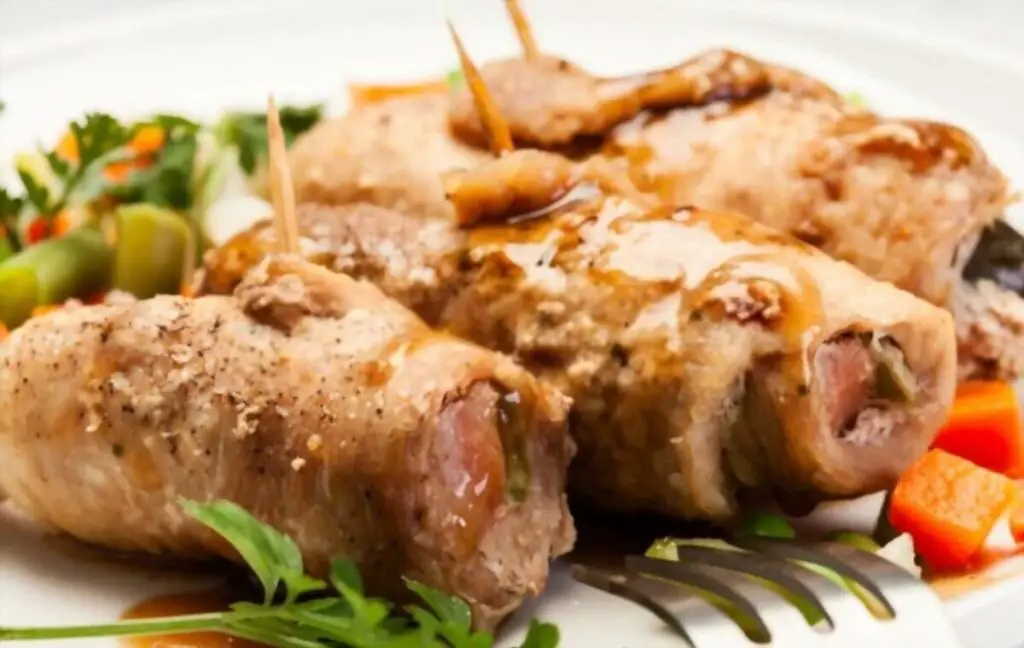
Experiencing Argentine Comfort: Niños Envueltos
History and Background
Delve into the comforting embrace of Argentina’s culinary heritage with Niños Envueltos, a dish that translates to “wrapped children.” Originating from the warmth of Argentine kitchens, this dish has been a cherished part of family meals for generations.
With roots in the Italian dish Braciolone, Niños Envueltos showcases the fusion of European and South American flavors. The name, “wrapped children,” reflects the nurturing essence of this dish, often prepared with love for the little ones at the heart of the family.
Argentina Food – Niños Envueltos Ingredients
Discover the ingredients needed to create this comforting Argentine dish:
- 1.5 lbs beef flank steak, thinly sliced
- 1 cup cooked rice
- 1 cup carrots, julienned
- 1 cup bell peppers (assorted colors), thinly sliced
- 1 cup peas, cooked
- 1 large onion, finely chopped
- 2 cloves garlic, minced
- 2 tablespoons olive oil
- 1 cup tomato sauce
- 1 cup beef broth
- Salt and pepper to taste
- Toothpicks (for securing the rolls)
Argentina Food – Niños Envueltos Recipe
Preparing the Filling
- In a pan, heat 1 tablespoon of olive oil over medium heat.
- Add minced garlic and chopped onion, sauté until softened.
- Stir in julienned carrots, bell peppers, and cooked peas. Cook until the vegetables are tender.
- Mix in cooked rice and season the filling with salt and pepper to taste.
Rolling the Niños Envueltos
- Lay out the thinly sliced beef flank steak and place a generous portion of the vegetable and rice filling on each slice.
- Roll the beef tightly around the filling and secure with toothpicks.
Cooking the Rolls
- In the same pan, heat the remaining olive oil.
- Place the rolled Niños Envueltos in the pan, searing on all sides until browned.
- Pour in tomato sauce and beef broth, covering the rolls.
- Simmer the rolls for 30-40 minutes, or until the beef is tender.
Serving and Enjoying
- Remove toothpicks before serving.
- Serve Niños Envueltos hot, spooning the flavorful sauce over the top.
Serving Size: 4-6 people
Cooking Time: 40-50 minutes
Nutritional Information (per serving):
- Calories: 350
- Protein: 25g
- Carbohydrates: 20g
- Fat: 18g
- Fiber: 3g
Experience the heartwarming flavors of Argentina with Niños Envueltos, a dish that brings together the comforting elements of family, tradition, and delicious cuisine. Perfect for sharing around the table with loved ones, this recipe captures the essence of Argentine comfort food.
Argentina Cuisine – Empanadas: The Savory Delight of Argentina
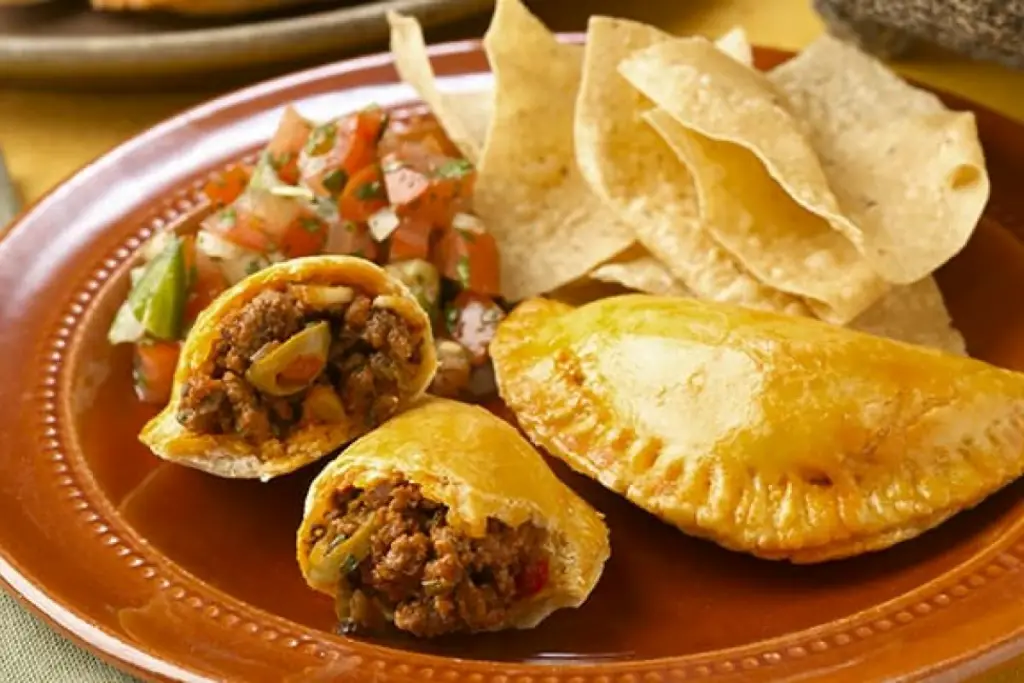
When it comes to traditional Argentinian cuisine, empanadas are a beloved icon. These hand-held savory pastries are a staple of Argentine cuisine and can be found in nearly every corner of the country.
But what exactly are empanadas? At their core, empanadas are turnovers filled with a variety of ingredients. Typical fillings include beef, chicken, ham and cheese, or spinach and cheese, but the possibilities are endless. The filling is wrapped in a pastry shell and then either baked or fried until golden and delicious.
Every region of Argentina has its own take on empanadas, with variations in fillings, spices, and even the shape of the pastry. Some regions use a flaky pastry while others use a sturdier dough that holds up better when fried.
Empanadas are a popular snack or appetizer, but they are also often served as a main course. When paired with a side salad or roasted vegetables, empanadas make for a satisfying and hearty meal.
At traditional gatherings or family events, empanadas are a must-have dish. Every family has their own recipe and secret ingredient, making them a deeply personal and cherished part of Argentine food culture.
But what makes empanadas so iconic in Argentine cuisine? The answer lies in their versatility and portability. Empanadas can be enjoyed on-the-go or as a sit-down meal, and their fillings can be adapted to suit any taste preference. They are a true representation of the diverse and vibrant food culture of Argentina.
So, the next time you find yourself in Argentina, be sure to try some empanadas. And if you can’t make it to the country, don’t worry – there are plenty of recipes available online to try making them at home.
Here’s a recipe for traditional Argentinean beef empanadas:
Argentina Cuisine – Empanadas Ingredients:
For the Filling:
- 500g ground beef
- 2 large onions, finely chopped
- 2 hard-boiled eggs, chopped
- 1/2 cup green olives, pitted and chopped
- 2 tablespoons vegetable oil
- 2 teaspoons paprika
- 1 teaspoon ground cumin
- 1/2 teaspoon chili powder (adjust to taste)
- Salt and pepper to taste
- 2 green onions, chopped (optional)
- 1/4 cup raisins (optional for a sweet touch)
For the Dough:
- 3 cups all-purpose flour
- 1/2 cup unsalted butter, cold and cut into small pieces
- 1 egg
- 1/2 cup water (approximate)
- 1 teaspoon salt
Argentina Cuisine – Empanadas Preparation Instructions:
Preparing the Filling
In a large skillet, heat the vegetable oil over medium heat. Add the chopped onions and sauté until translucent. Add the ground beef and cook until browned, breaking it up with a spoon as it cooks. Stir in the paprika, cumin, chili powder, salt, and pepper.
Once the beef is fully cooked, remove from heat and let it cool. Once cooled, mix in the chopped hard-boiled eggs, olives, green onions (if using), and raisins (if using). Set aside.
Making the Dough
In a large bowl, combine the flour and salt. Add the cold butter pieces and use your fingers or a pastry cutter to incorporate the butter into the flour until the mixture resembles coarse crumbs. Beat the egg and mix it into the flour mixture. Gradually add water, a little at a time, until the dough comes together. Knead the dough on a floured surface until smooth. Wrap in plastic wrap and refrigerate for at least 1 hour.
Assembling the Empanadas
Preheat your oven to 200°C (400°F). Roll out the dough on a floured surface to about 1/8-inch thickness. Using a round cutter or a glass, cut out circles from the dough. Place a spoonful of the beef filling in the center of each circle. Fold the dough over the filling to create a half-moon shape. Press the edges with a fork to seal. Place the empanadas on a baking sheet lined with parchment paper.
Baking
Bake the empanadas in the preheated oven for 20-25 minutes or until they are golden brown.
Serve the Argentinean empanadas hot with chimichurri sauce or any dipping sauce of your choice. Enjoy!
Argentina Cuisine – Bife de chorizo
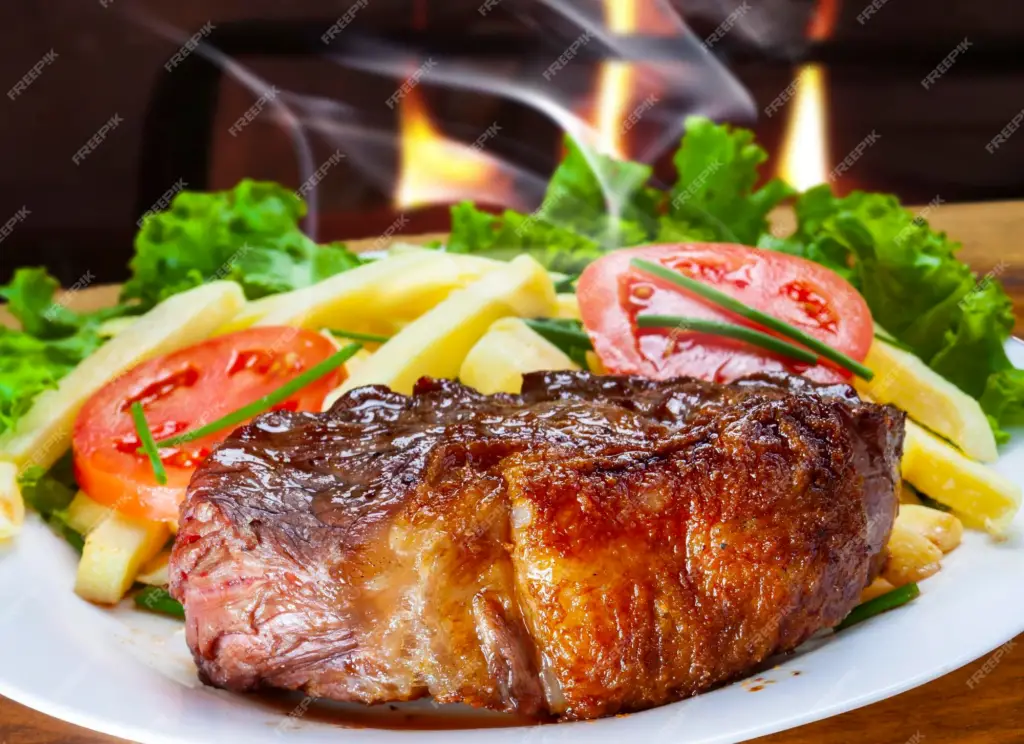
Bife de Chorizo” is not related to the spicy sausage “chorizo” that many might be familiar with. In Argentina, “Bife de Chorizo” refers to a specific cut of beef, which is similar to a sirloin or New York strip steak. It’s a thick, juicy steak that’s often grilled and is a staple in Argentinean cuisine, especially in the country’s famed steakhouses or “parrillas.”
Here’s a simple recipe to prepare a traditional Argentinean Bife de Chorizo:
Argentina Cuisine – Bife de chorizo Ingredients:
- 2 Bife de Chorizo steaks (sirloin or New York strip steaks), about 1 to 1.5 inches thick
- Coarse sea salt
- Freshly ground black pepper
- Olive oil or vegetable oil (optional)
- Chimichurri sauce (for serving)
Argentina Cuisine – Bife de chorizo Preparation Instructions:
Preparation
Remove the steaks from the refrigerator and let them come to room temperature for about 30 minutes to an hour. This ensures even cooking.
Seasoning
Generously season both sides of the steaks with coarse sea salt and freshly ground black pepper. If you like, you can lightly brush the steaks with olive oil or vegetable oil, but this is optional as the natural fats in the steak will help in the grilling process.
Grilling
Preheat your grill to high heat. If you’re using a charcoal grill, let the coals burn until they’re covered with white ash. Place the steaks on the grill and cook for about 4-5 minutes on each side for medium-rare, or until they reach your desired level of doneness. The high heat will sear the outside, giving it a nice crust, while keeping the inside juicy.
- Note: The exact cooking time will depend on the thickness of your steaks and the heat of your grill. It’s always a good idea to use a meat thermometer to check for doneness. For medium-rare, aim for an internal temperature of about 130°F (54°C).
Resting
Once cooked to your liking, remove the steaks from the grill and let them rest on a cutting board or plate for about 5 minutes. This allows the juices to redistribute throughout the steak, ensuring a juicy bite.
Serving
Serve the Bife de Chorizo with chimichurri sauce on the side. In Argentina, it’s also common to serve steaks with simple side dishes like grilled vegetables, potatoes, or a green salad.
Enjoy your Argentinean Bife de Chorizo with a glass of Malbec or any other favorite wine!
Argentina Cuisine – Asado: The Art of Argentine Barbecue
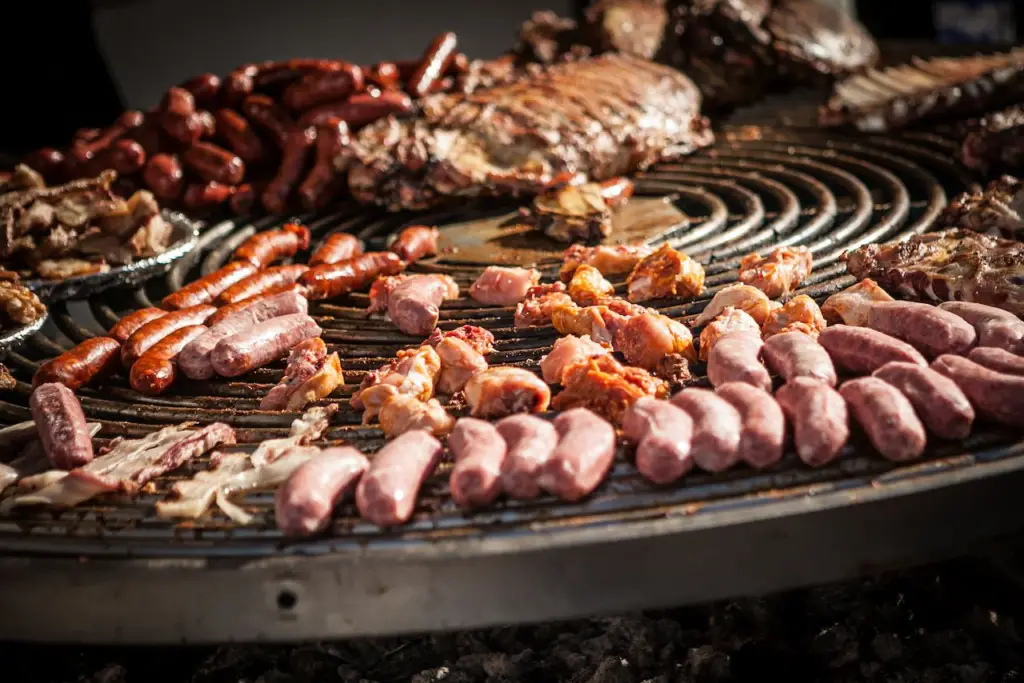
When it comes to traditional Argentina Cuisine, few dishes are as famous as asado, or Argentine barbecue. Asado is more than just a meal; it’s a cultural experience that brings together family and friends to enjoy succulent meats, grilled to perfection.
At its core, asado is a simple dish that relies on high-quality meat, a wood-fired grill, and the skilled hands of the cook. But in Argentina, asado is also a ritual, with specific cuts of meat and cooking methods that vary by region.
The star of any asado is the meat, which typically includes cuts like chorizo, morcilla (blood sausage), chinchulines (small intestines), and of course, the iconic bife de chorizo (sirloin steak). The meat is seasoned with just a few simple ingredients, like salt and chimichurri sauce, and then cooked over a wood fire until it’s juicy and tender.
In Argentina, the cooking of asado is not just a job for the grill master, but a communal effort. Friends and family gather around the grill, sipping wine and chatting as the meat cooks to perfection. It’s a social event that can last for hours, with each course of meat being served alongside fresh bread and salads.
So if you want to experience traditional Argentinian cuisine, be sure to try asado. This famous Argentine dish is a must-try for anyone looking to explore the rich food culture of this vibrant South American country.
Here’s a basic recipe and preparation guide for a traditional Argentinean Asado:
Argentina Cuisine – Asado Ingredients:
- Beef ribs, flanken style (with bones)
- Chorizos (Argentinean sausages)
- Morcilla (blood sausage) – optional
- Chicken, cut into pieces (optional)
- Coarse sea salt
- Chimichurri sauce (for serving)
Argentina Cuisine – Asado Preparation Instructions:
Preparation of the Grill (Parrilla)
Use wood or charcoal for the fire. Light your fire and let it burn until the wood or charcoal turns to embers. The heat should be medium, and there should be no flames by the time you start cooking. In traditional Argentinean asados, the heat is controlled by moving the embers and adjusting the grill height.
Seasoning the Meat
The beauty of an asado is in its simplicity. Generously season the beef ribs and other meats with coarse sea salt. There’s no need for marinades or other seasonings; the flavor of the meat, combined with the smoke from the grill, is the star.
Grilling
Start with the beef ribs, as they take the longest. Place them bone side down on the grill. The chorizos, morcilla, and chicken (if using) will cook faster, so add them to the grill a bit later. Turn the meats occasionally, ensuring they cook evenly. The ribs should be golden brown and slightly crispy on the outside.
Note: Cooking times will vary based on the thickness of the meat and the heat of your grill. Ribs might take 1.5 to 2 hours, while sausages and chicken will be faster, usually around 30 minutes.
Serving
Once cooked to your liking, remove the meats from the grill and let them rest for a few minutes. Slice the ribs between the bones and cut the sausages into portions. Serve with chimichurri sauce on the side.
Sides
Traditional sides for an asado include grilled vegetables (like bell peppers, onions, and tomatoes), simple green salads, and bread. Potatoes, either roasted or in a salad, are also common.
Drink Pairings
A classic Argentinean asado pairs wonderfully with Malbec wine. You can also enjoy it with other red wines, beer, or the traditional Argentinean drink, yerba mate.
Enjoy your Argentinean Asado experience, and remember, it’s as much about the company and the process as it is about the food!
Argentina Cuisine – Chimichurri Sauce: The Tangy Companion to Argentine Grilled Meats

One of the most iconic condiments in traditional Argentina Cuisine is chimichurri sauce. This tangy sauce is the perfect accompaniment to grilled meats and adds a burst of flavor to any dish. At its core, chimichurri is a simple blend of herbs, garlic, oil, and vinegar, but the combination of flavors is what makes it so exceptional.
The origins of chimichurri are somewhat unclear, but it’s believed that the sauce has been a part of Argentine food culture for centuries. Today, it’s a staple in many Argentine households and restaurants, and is often served alongside grilled meats like asado.
The key to making the perfect chimichurri sauce is to find the right balance of ingredients. Some recipes call for parsley, while others prefer cilantro, and some even incorporate oregano. Garlic is a must-have ingredient, and the amount used can vary depending on personal preference. Olive oil and vinegar are also essential, with red wine vinegar being the most common choice.
To make chimichurri sauce, simply combine chopped herbs and garlic in a bowl and whisk in olive oil and vinegar. Some recipes call for additional ingredients like red pepper flakes or lemon juice for added flavor. The result is a sauce that’s bright, tangy, and packed with flavor.
Chimichurri sauce is not just limited to grilled meats, though. It can also be used as a marinade, salad dressing, or even as a topping for baked potatoes. The possibilities are endless, making chimichurri a versatile and essential component of traditional Argentinian cuisine.
Here’s a traditional recipe for Argentinean Chimichurri Sauce:
Argentina Cuisine – Chimichurri Sauce Ingredients:
- 1 cup fresh flat-leaf parsley, finely chopped
- 4 cloves garlic, minced
- 2 tablespoons fresh oregano leaves, finely chopped (or 2 teaspoons dried oregano)
- 1/2 cup extra-virgin olive oil
- 2 tablespoons red wine vinegar
- 1 teaspoon sea salt
- 1/4 teaspoon freshly ground black pepper
- 1/4 teaspoon red pepper flakes (adjust to taste)
- 2 tablespoons fresh lemon juice (optional)
Argentina Cuisine – Chimichurri Sauce Preparation Instructions:
- Mixing the Herbs: In a mixing bowl, combine the finely chopped parsley, minced garlic, and oregano.
- Adding Liquids: Pour in the olive oil and red wine vinegar. If you’re using lemon juice, add it now. This gives the sauce a tangy kick.
- Seasoning: Add the salt, black pepper, and red pepper flakes. Adjust the seasoning according to your taste. If you prefer a spicier sauce, you can add more red pepper flakes.
- Combining: Stir everything together until well combined. The sauce should have a slightly chunky texture.
- Resting: Let the chimichurri sit for at least 10 minutes to allow the flavors to meld. For the best flavor, cover and let it sit in the refrigerator for a couple of hours or overnight.
- Serving: Before serving, give the sauce a good stir. If it has been refrigerated, you might want to let it come to room temperature.
Chimichurri sauce is best enjoyed fresh but can be stored in an airtight container in the refrigerator for up to a week. It’s perfect for drizzling over grilled meats, especially beef, but can also be used as a marinade or a dipping sauce for bread.
Enjoy your Argentinean Chimichurri Sauce with your favorite grilled dishes!
Argentina Cuisine – Dulce de Leche: Argentina’s Sweet Sensation

When it comes to traditional Argentina Cuisine, there is no dessert more famous than dulce de leche. This creamy, caramel-like treat is a staple in Argentine homes and bakeries alike, and its popularity has spread far beyond the country’s borders.
The origins of dulce de leche can be traced back to the early 19th century, where legend has it that a cook accidentally left a pot of milk and sugar on the stove for too long. The result was a thick, caramel-like substance that was quickly embraced as a delicious new dessert.
Today, dulce de leche is used in a variety of ways in Argentina Cuisine. It’s spread on toast or crackers, used as a filling for pastries and cakes, and even served alongside ice cream or fresh fruit. The possibilities are endless!
In fact, dulce de leche is so beloved in Argentina that there’s even a National Dulce de Leche Day, celebrated every year on October 11th.
To make your own dulce de leche, all you need is a few simple ingredients: milk, sugar, and vanilla extract. Heat the milk and sugar together in a pot until it starts to thicken, then add the vanilla extract and continue cooking until the mixture reaches the desired consistency. It’s as easy as that!
Whether you’re indulging in a traditional Argentine dessert or trying your hand at making dulce de leche at home, this sweet sensation is an essential part of the country’s food culture that is sure to satisfy any sweet tooth.
Here’s a traditional recipe:
Argentina Cuisine – Dulce de Leche Ingredients:
- 1 liter (4 cups) whole milk
- 1 1/4 cups granulated sugar
- 1/4 teaspoon baking soda
- 1 teaspoon vanilla extract (optional)
Argentina Cuisine – Dulce de Leche Preparation Instructions:
- Combining Ingredients: In a large, heavy-bottomed pot, combine the milk, sugar, and baking soda. Stir until the sugar is dissolved.
- Simmering: Place the pot over medium heat. Bring the mixture to a simmer, stirring constantly to prevent the milk from burning or forming a skin on top.
- Reducing Heat: Once the mixture is simmering, reduce the heat to low. Continue to cook, stirring frequently, for 1.5 to 2 hours, or until the mixture has thickened and turned a caramel color. It’s essential to keep an eye on it and stir regularly to prevent it from sticking to the bottom of the pot.
- Testing Consistency: To check if the Dulce de Leche is ready, drop a small amount on a cold plate. It should spread slowly. If it’s too runny, continue cooking for a bit longer.
- Finishing Touch: Once the desired consistency is achieved, remove the pot from the heat. If you’re using vanilla extract, stir it in now.
- Cooling and Storing: Allow the Dulce de Leche to cool for a few minutes in the pot, then transfer it to clean glass jars. Seal the jars and let them cool to room temperature. Once cooled, store them in the refrigerator. The Dulce de Leche will continue to thicken as it cools.
Dulce de Leche can be spread on toast, drizzled over pancakes or waffles, used as a filling for cakes and pastries, or simply enjoyed by the spoonful. It’s a versatile sweet treat that’s adored by many!
Enjoy your homemade Argentinean Dulce de Leche!
Conclusion
Exploring the national dish and recipes of Argentina has been an exciting journey into the heart of this vibrant South American country’s food culture. From traditional Argentinian cuisine to iconic dishes that have gained worldwide fame, we have uncovered the secrets behind these flavorful creations.
Argentina’s culinary heritage is a feast for the senses, and we hope that our exploration has left you craving more. The typical Argentine cuisine, famous Argentine dishes, and iconic dishes like empanadas, asado, chimichurri sauce, and dulce de leche offer a tantalizing glimpse into the country’s food culture.
So why not add a little bit of Argentina to your culinary repertoire? Try your hand at making traditional dishes like asado or empanadas, or experiment with the tangy flavors of chimichurri sauce and the creamy sweetness of dulce de leche. You won’t be disappointed!
Thank you for joining us on this exploration of Argentina National Dish and recipes. We hope you have enjoyed the journey as much as we have.
FAQ’s
What is Argentina National Dish?
The Argentina national dish is asado, a traditional barbecue consisting of various cuts of meat such as beef, pork, and sausages. It is cooked over an open fire or grill, resulting in a flavorful and tender meal. Asado is a beloved culinary tradition in Argentina and often enjoyed with friends and family.
What can you expect from the Cuisine of Argentina?
The cuisine of Argentina reflects a fusion of various cultural influences. Known for its famous beef dishes and traditional asado (barbecue), Argentine cuisine also features empanadas, chimichurri sauce, and the popular sweet treat dulce de leche.
Its diverse culinary traditions make the cuisine of Argentina a haven for food enthusiasts.
What are some famous Argentine dishes?
Some famous Argentine dishes include empanadas, chimichurri sauce, and dulce de leche.
What is empanadas?
Empanadas are delicious savory pastries that are a staple in Argentine cuisine. They are filled with various ingredients such as meat, cheese, or vegetables.
What is Asado?
Asado is an artful grilling technique that is deeply ingrained in Argentine culture. It involves the selection of high-quality meats and slow-cooking them over an open fire or grill.
What is chimichurri sauce?
Chimichurri sauce is a tangy and flavorful condiment that is often served with Argentine grilled meats. It is made with a combination of herbs, garlic, vinegar, and olive oil.
What is dulce de leche?
Dulce de leche is a creamy, caramel-like treat that is widely enjoyed in Argentina. It is made by slowly caramelizing sweetened condensed milk.

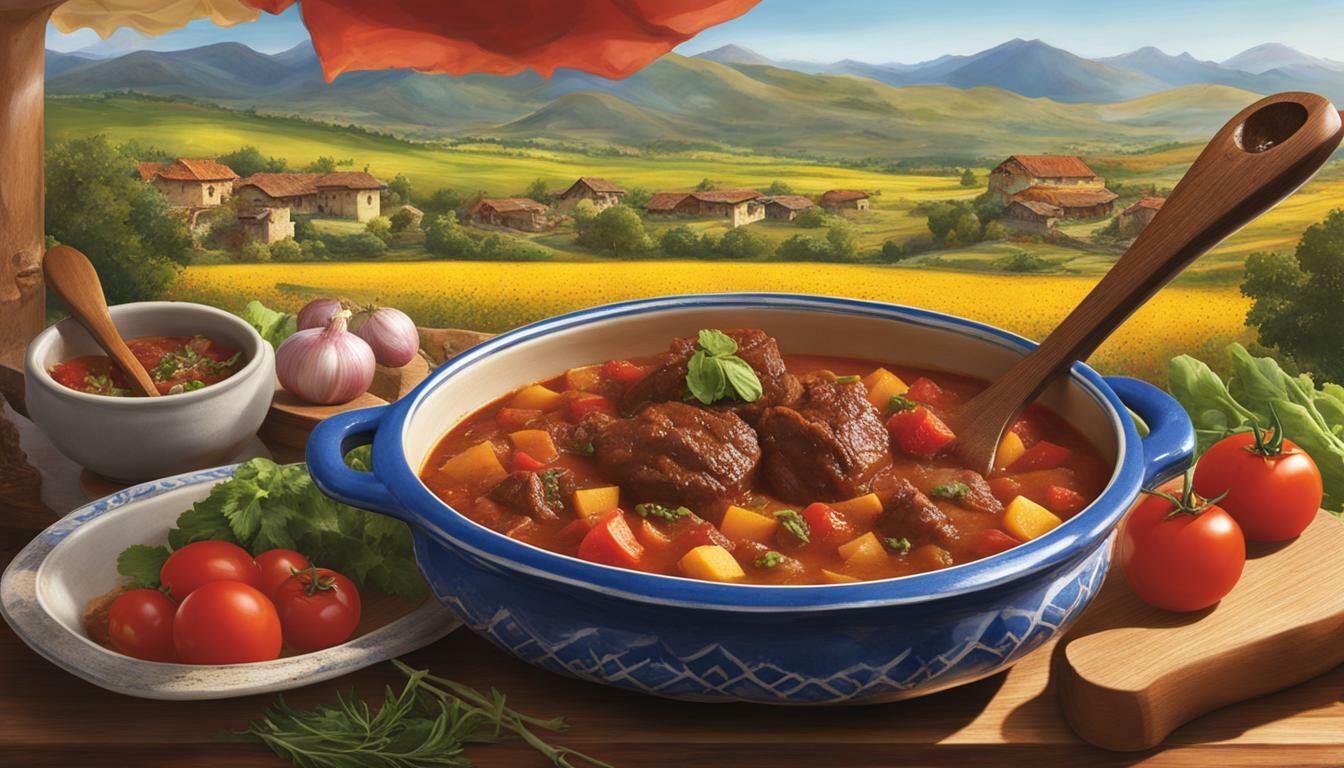
abc